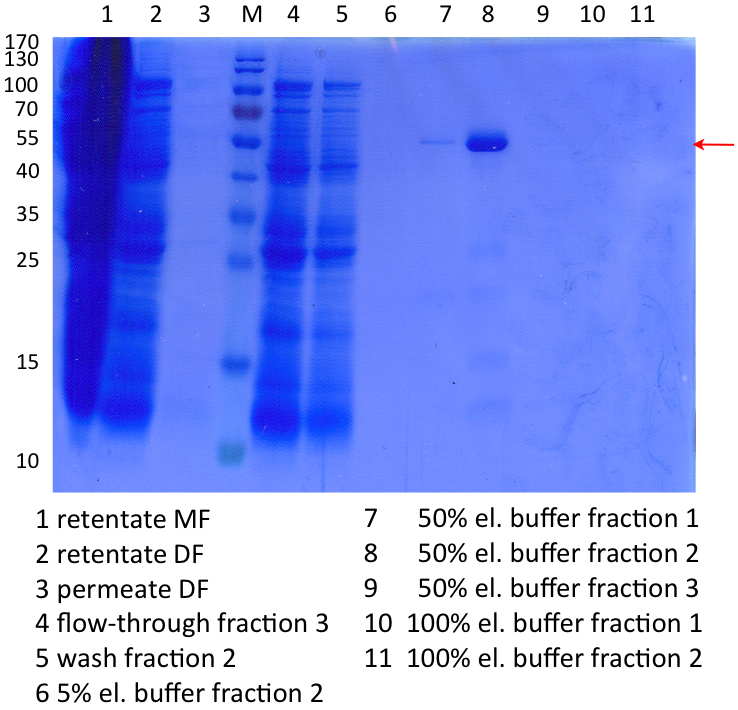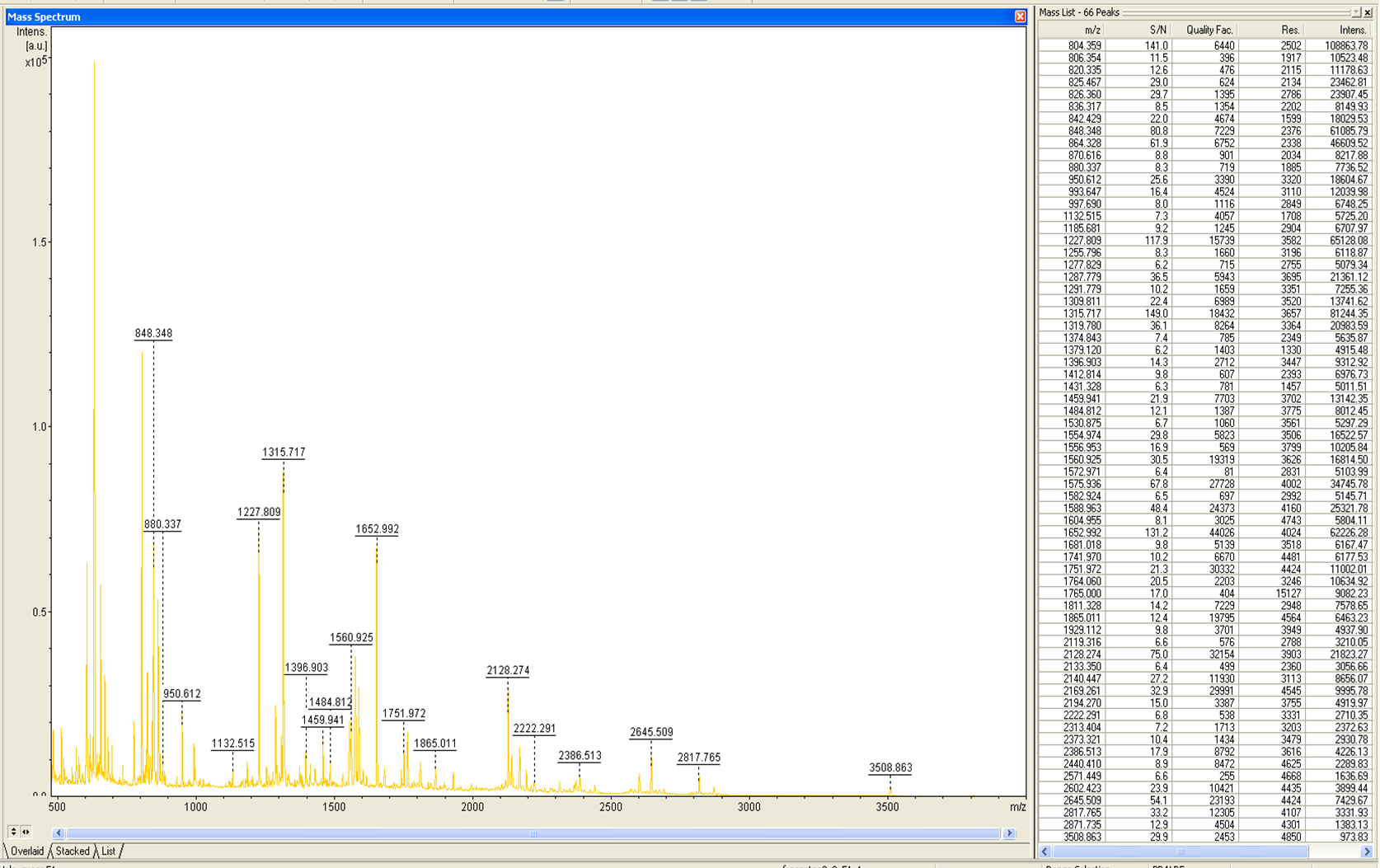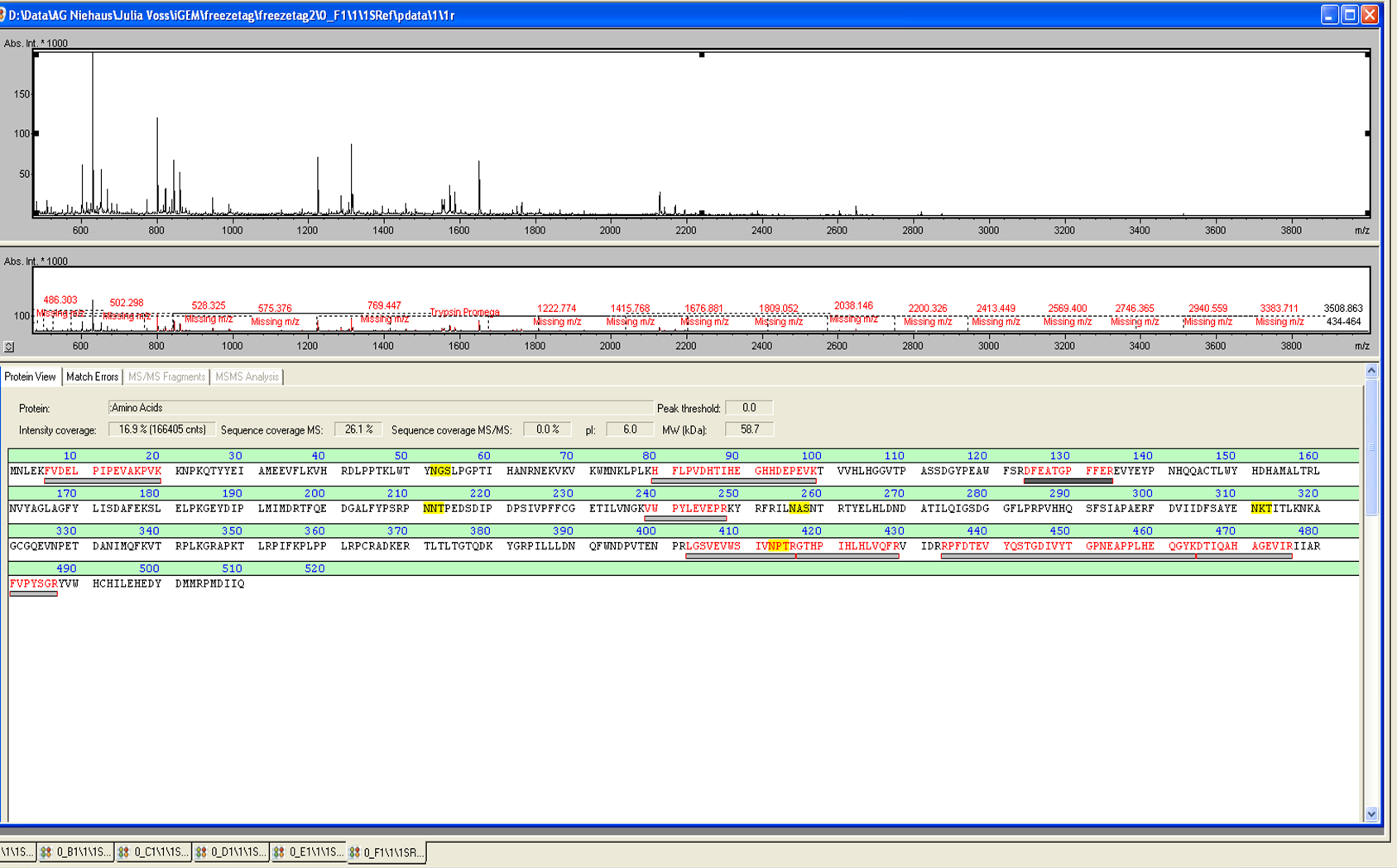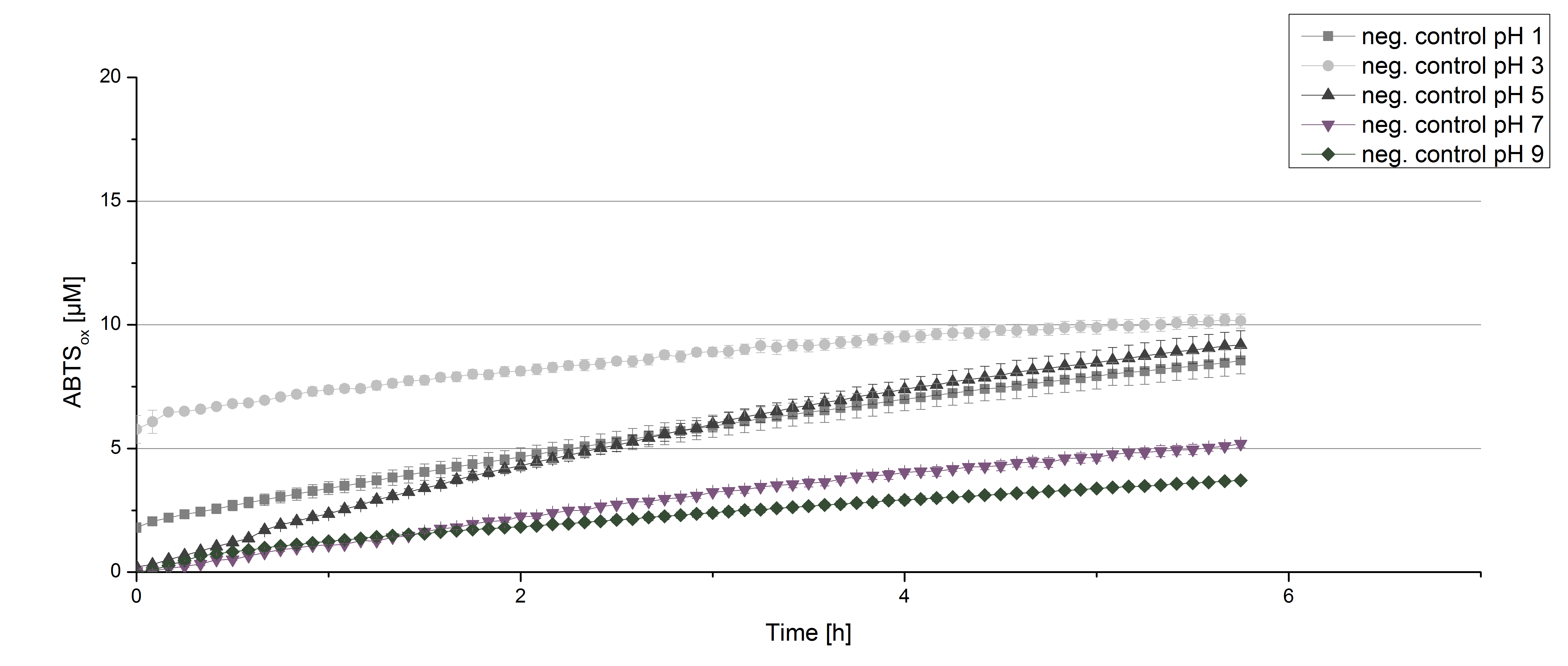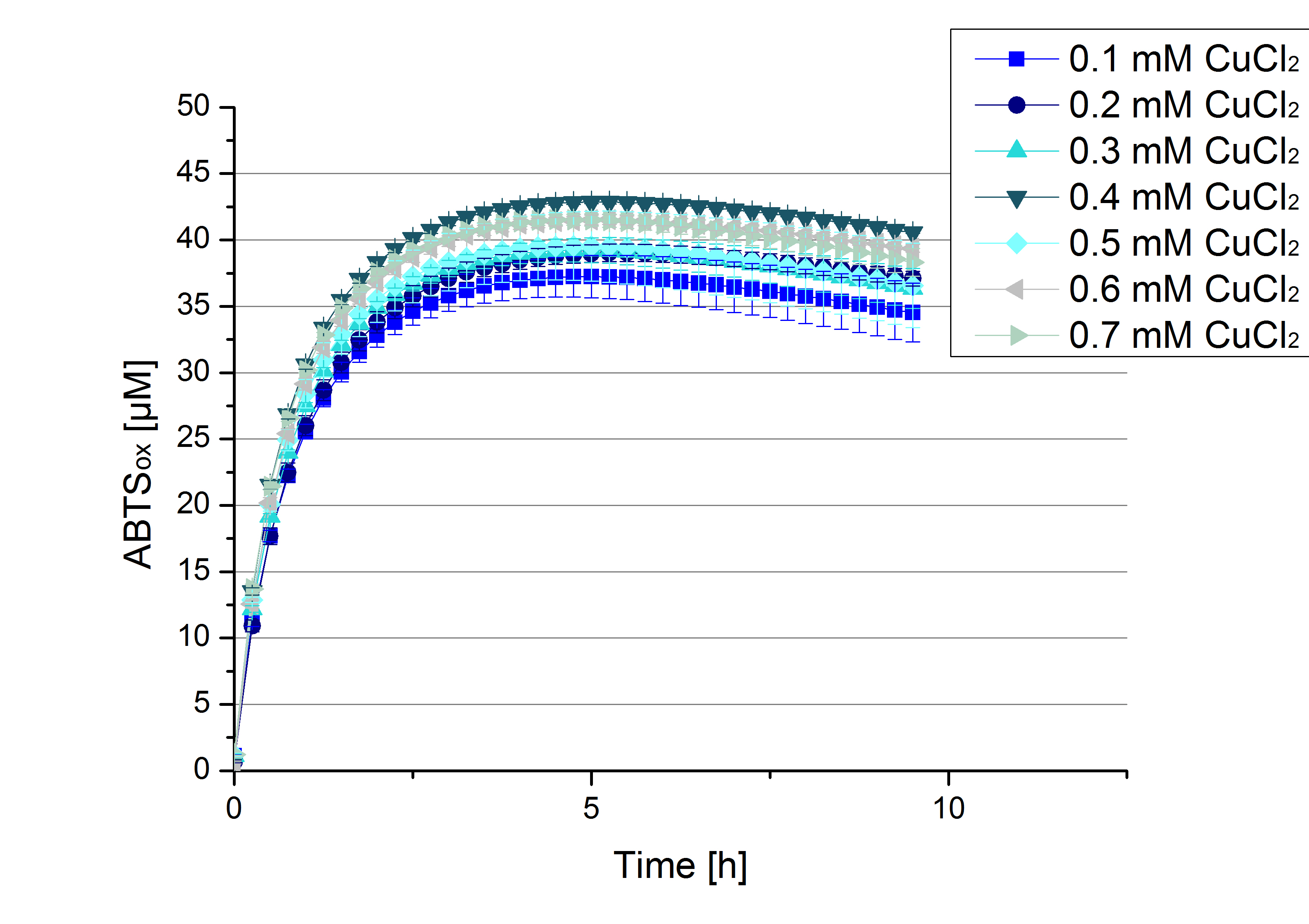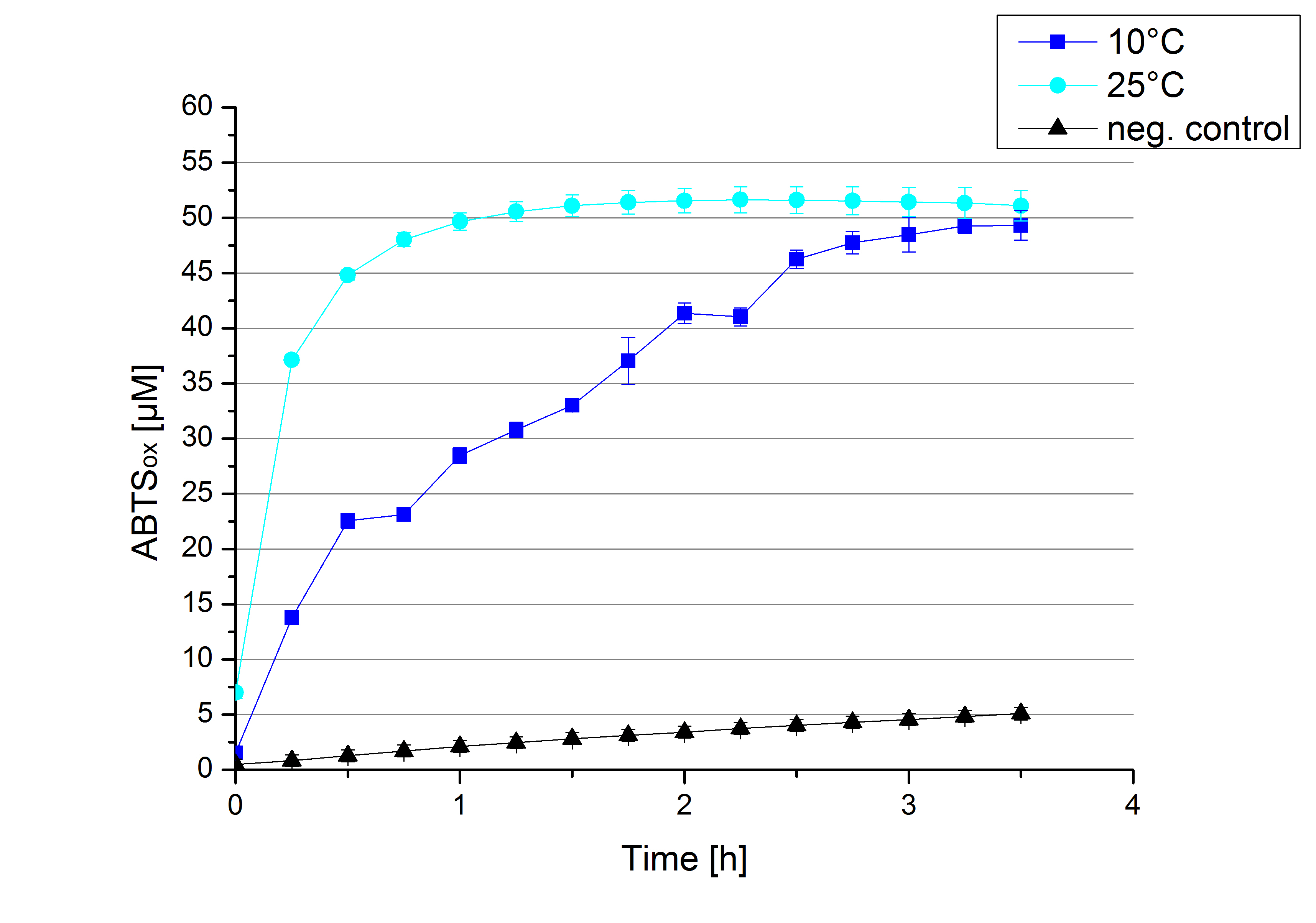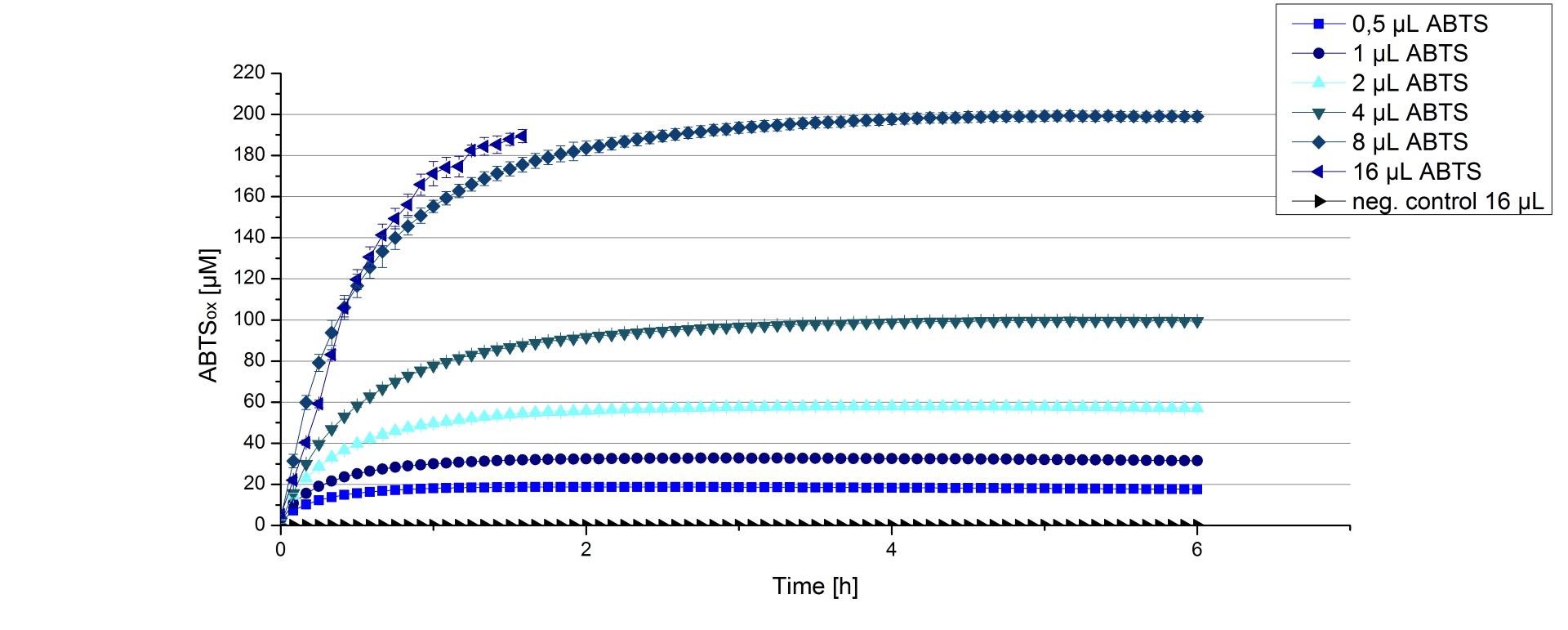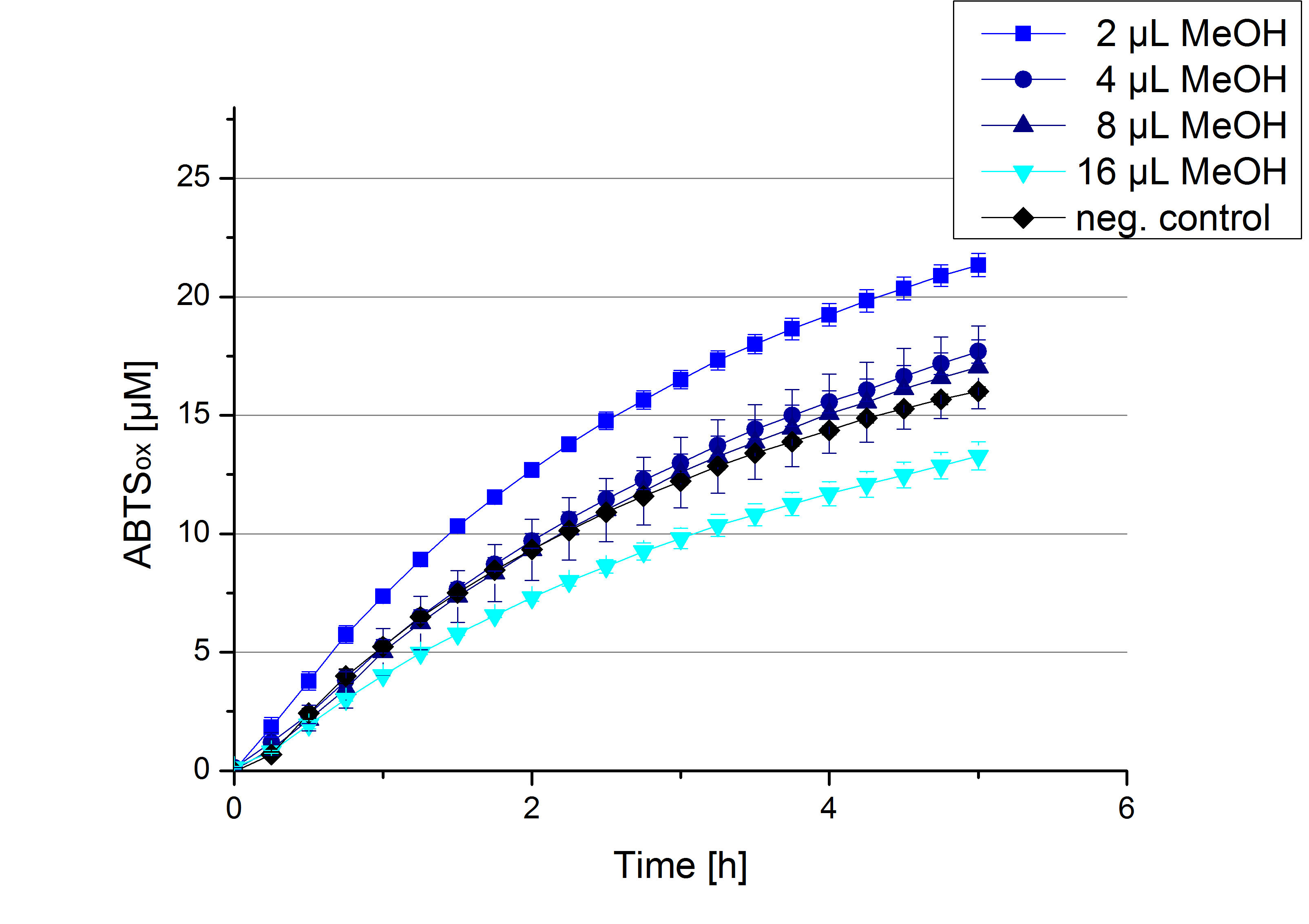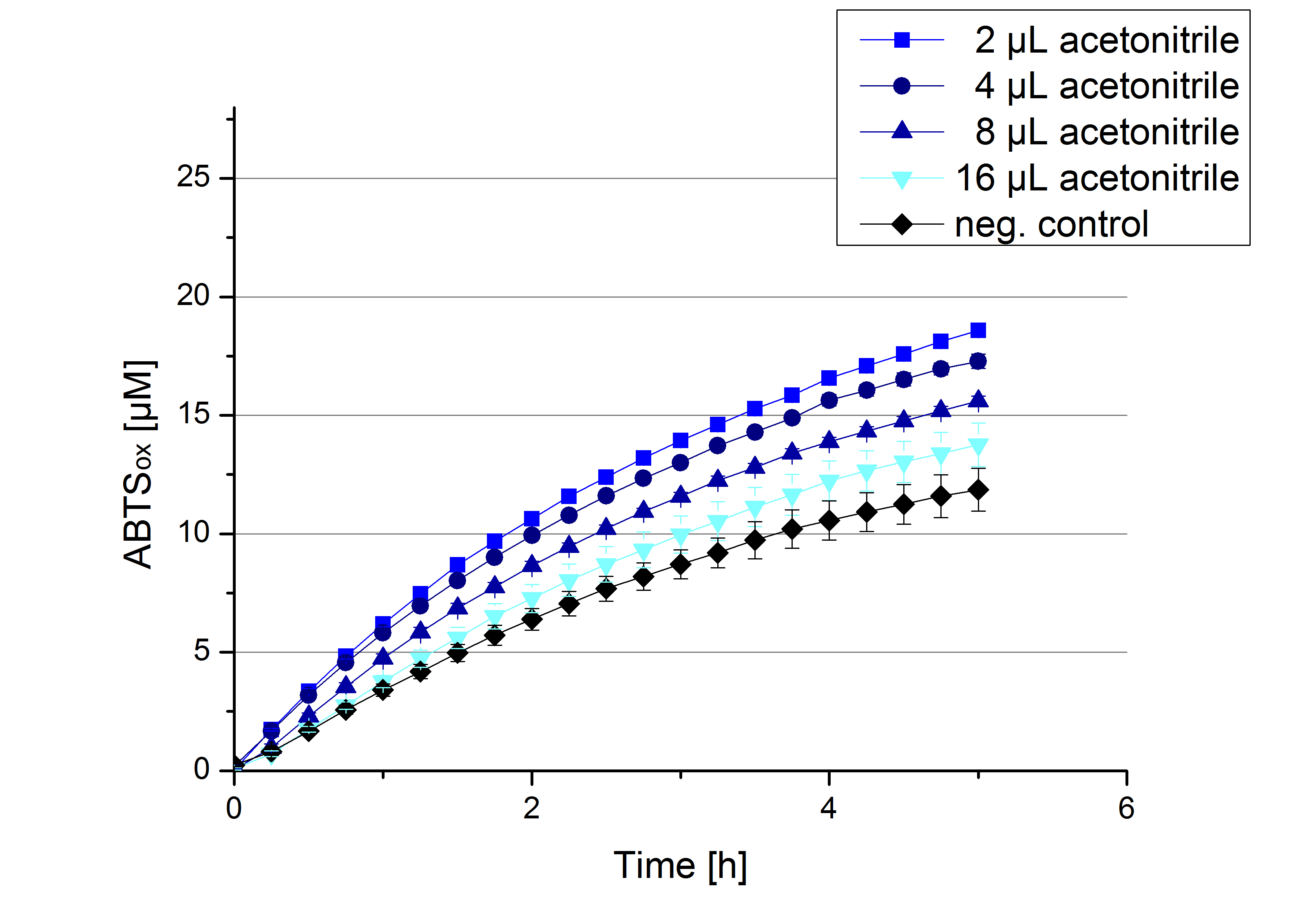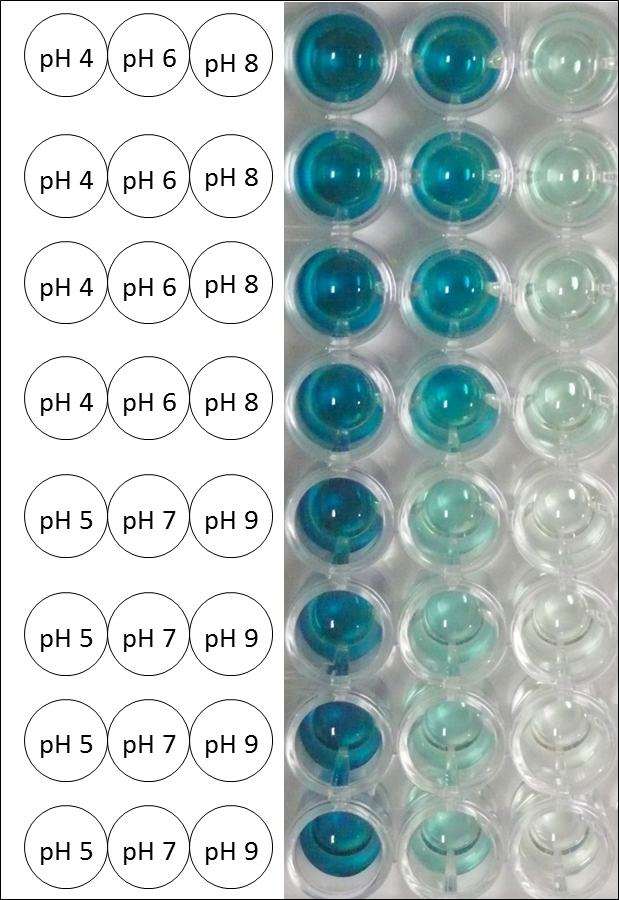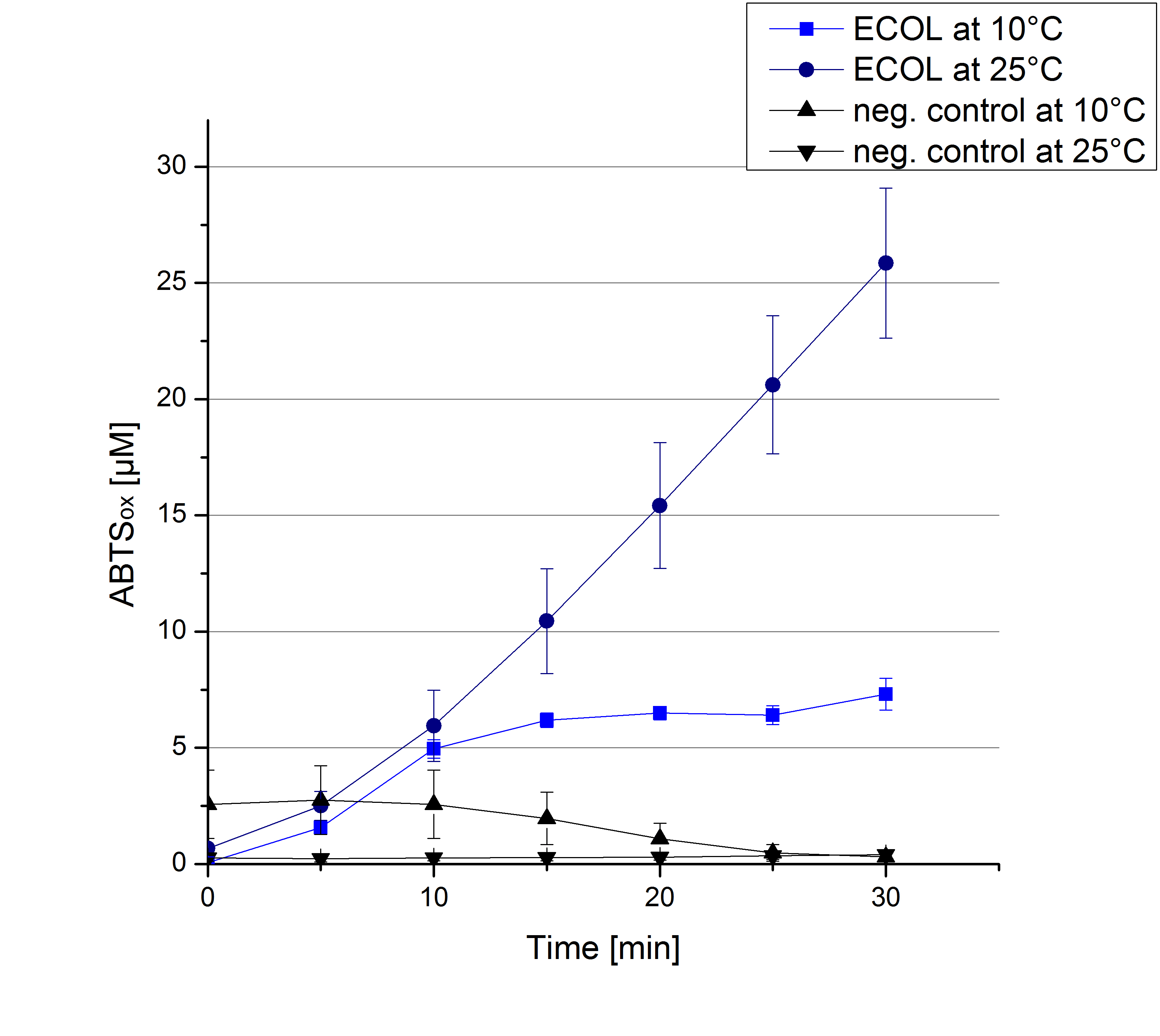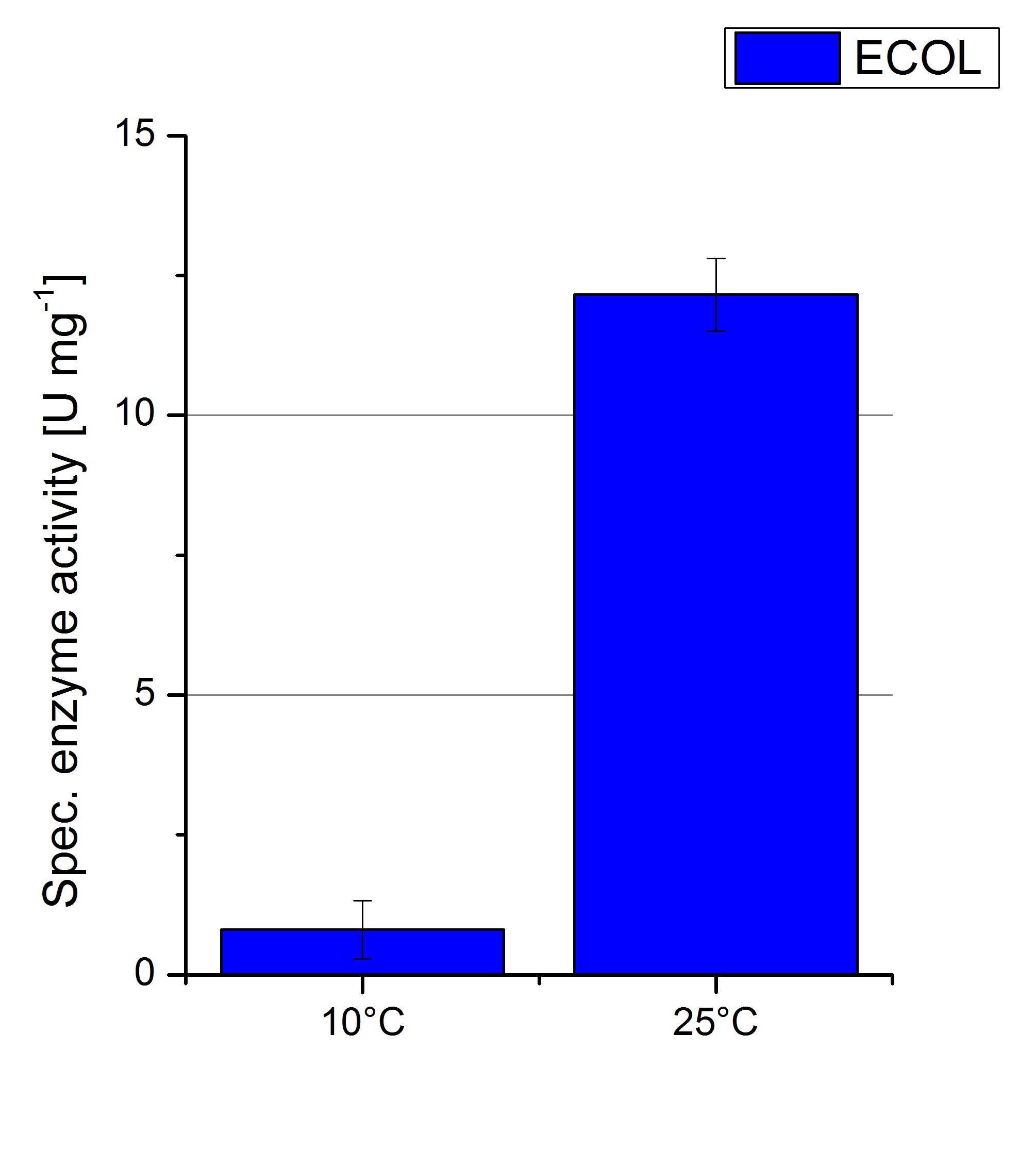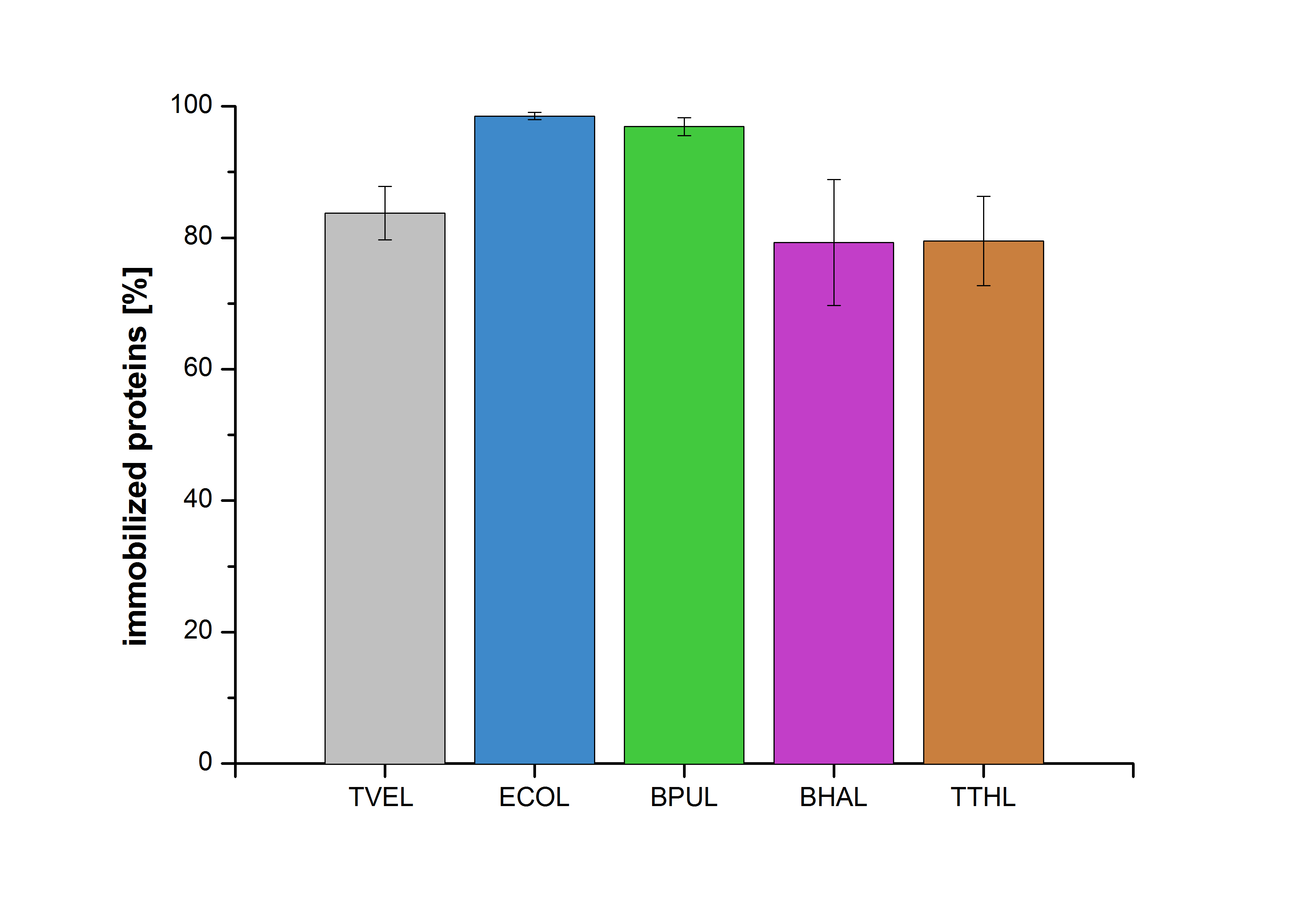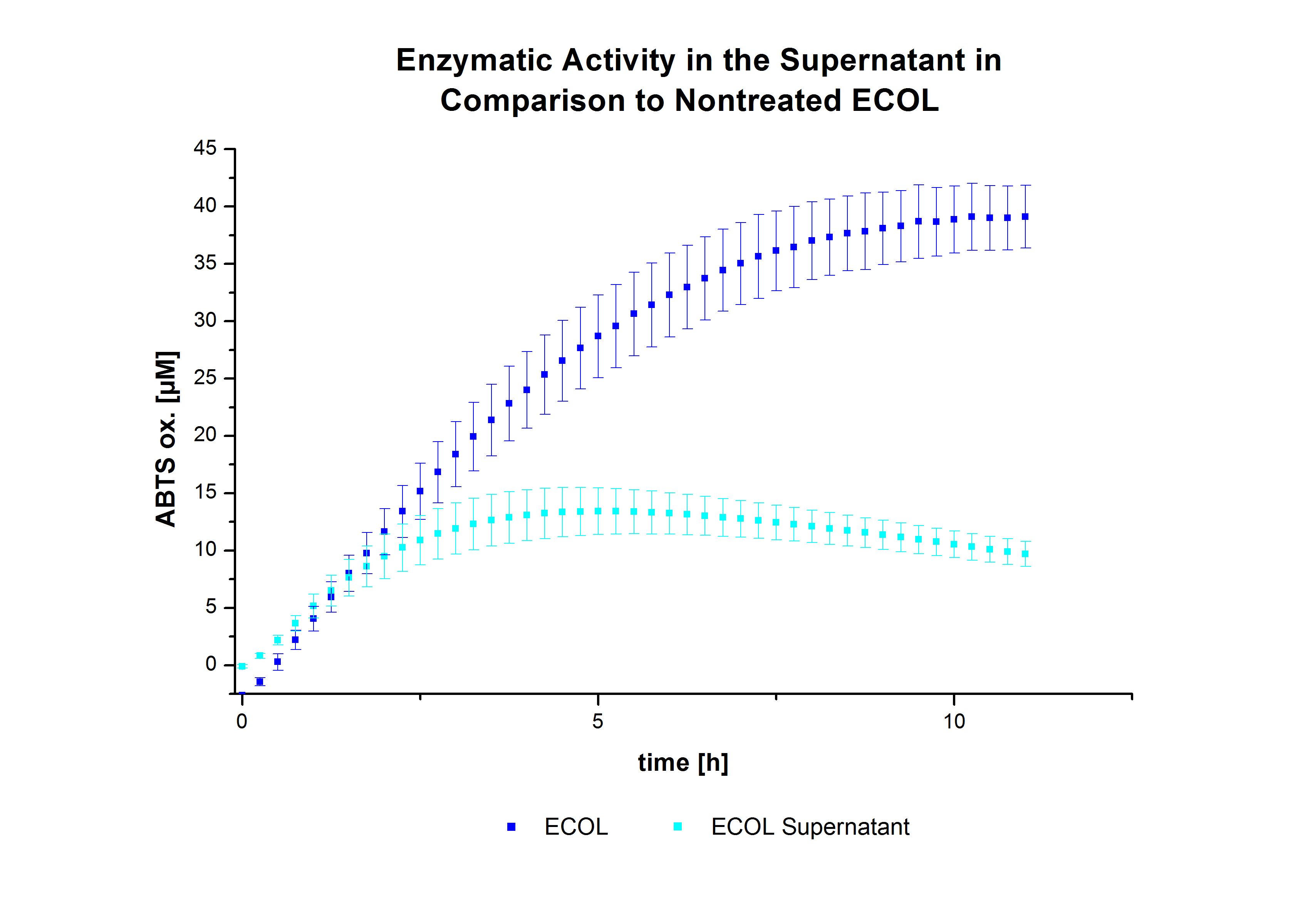Team:Bielefeld-Germany/Results/coli
From 2012.igem.org
(→Immobilisation) |
(→Since Regionals: 12 L Fermentation E. coli KRX with BBa_K863005) |
||
| (169 intermediate revisions not shown) | |||
| Line 4: | Line 4: | ||
<div id=page-title> | <div id=page-title> | ||
<span id=page-title-text> | <span id=page-title-text> | ||
| - | Laccase CueO from <a href=" | + | Laccase CueO from <a href="http://openwetware.org/wiki/E._coli_genotypes#BL21.28DE3.29"> <i>Escherichia coli</i> BL21 (DE3)</a> |
</span> | </span> | ||
</div> | </div> | ||
| Line 13: | Line 13: | ||
<p class="more"> | <p class="more"> | ||
</html> | </html> | ||
| - | First some trials of shaking flask cultivations were made with changing parameters to identify the best conditions for the production of the laccase CueO from | + | First some trials of shaking flask cultivations were made with changing parameters to identify the best conditions for |
| + | the production of the laccase CueO from E. coli BL21 (DE3) named ECOL fused to a His tag. Because of no measured activity | ||
| + | in the cell lysate a purification method was established (using Ni-NTA His tag resin and Syringe or ÄKTA method). The purified | ||
| + | ECOL could be identified by SDS-PAGE (molecular weight of 53.4 kDa) as well as by MALDI-TOF. The fractionated samples were also | ||
| + | tested concerning their activity. A maximal activity of 55% was reached, measured in ABTS<sub>ox</sub> [µM]. After measuring activity of ECOL a scale up was made up to | ||
| + | 3 L and then also up to 6 L that enables an intense screening afterwards. A further scale up to 12 L with a optimized medium was implemented to enable additional experiments to characterize ECOL. Additional scale up experiments will be important for further application. The enzyme was characterized further | ||
| + | regarding its temperature and pH optimum and concerning the influence of different concentrations of CuCl<sub>2</sub>, ABTS, MeOH and acetonitrile. A total specific enzyme activity of 5,5 U mg<sup>-1</sup> was determined for ECOL at pH 5 at 25°C with ABTS as a substrate. | ||
<html> | <html> | ||
</p> | </p> | ||
| Line 35: | Line 41: | ||
===3 L Fermentation ''E. coli'' KRX with <partinfo>BBa_K863005</partinfo>=== | ===3 L Fermentation ''E. coli'' KRX with <partinfo>BBa_K863005</partinfo>=== | ||
| - | [[File:Bielefeld2012_ECOL3LFermentation.jpg|450px|thumb|left|'''Figure 1 | + | [[File:Bielefeld2012_ECOL3LFermentation.jpg|450px|thumb|left|'''Figure 1''': Fermentation of ''E. coli'' KRX with <partinfo>BBa_K863005</partinfo> (ECOL) in an Infors Labfors Bioreactor, scale: 3 L, [https://2012.igem.org/Team:Bielefeld-Germany/Protocols/Materials#Autoinduction_medium autoinduction medium] + 60 µg/mL chloramphenicol, 37 °C, pH 7, agitation on cascade to hold pO<sub>2</sub> at 50 %, OD<sub>600</sub> measured every 30 minutes.]] |
<p align="justify"> | <p align="justify"> | ||
| Line 47: | Line 53: | ||
<p align="justify"> | <p align="justify"> | ||
| - | The harvested cells were resuspended in [https://2012.igem.org/wiki/index.php?title=Team:Bielefeld-Germany/Protocols/Materials#Buffers_for_His-Tag_affinity_chromatography Ni-NTA- equilibration buffer], mechanically disrupted by [https://2012.igem.org/Team:Bielefeld-Germany/Protocols/Production#Mechanical_lysis_of_the_.28bio-reactor.29_cultivation homogenization] and cell debris were removed by centrifugation. The supernatant of the cell lysate was loaded on the Ni-NTA column (15 mL Ni-NTA resin) with a flow rate of 1 mL min<sup>-1</sup> cm<sup>-2</sup>. Then the column was washed with 10 column volumes (CV) [https://2012.igem.org/wiki/index.php?title=Team:Bielefeld-Germany/Protocols/Materials#Buffers_for_His-Tag_affinity_chromatography Ni-NTA equilibration buffer]. The bound proteins were eluted by an increasing [https://2012.igem.org/wiki/index.php?title=Team:Bielefeld-Germany/Protocols/Materials#Buffers_for_His-Tag_affinity_chromatography Ni-NTA elution buffer] step elution from 5 % (equates to 25 mM imidazol) with a length of 50 mL, to 50 % (equates to 250 mM imidazol) with a length of 60 mL, to 80 % (equates to 400 mM imidazol) with a length of 40 mL and finally to 100 % (equates to 500 mM imidazol) with a length of 80 mL. This strategy was chosen to improve the purification caused by a step by step increasing Ni-NTA-elution buffer concentration. The elution was collected in 10 mL fractions. | + | The harvested cells were resuspended in [https://2012.igem.org/wiki/index.php?title=Team:Bielefeld-Germany/Protocols/Materials#Buffers_for_His-Tag_affinity_chromatography Ni-NTA- equilibration buffer], mechanically disrupted by [https://2012.igem.org/Team:Bielefeld-Germany/Protocols/Production#Mechanical_lysis_of_the_.28bio-reactor.29_cultivation homogenization] and cell debris were removed by centrifugation. The supernatant of the cell lysate was loaded on the Ni-NTA column (15 mL Ni-NTA resin) with a flow rate of 1 mL min<sup>-1</sup> cm<sup>-2</sup>. Then the column was washed with 10 column volumes (CV) [https://2012.igem.org/wiki/index.php?title=Team:Bielefeld-Germany/Protocols/Materials#Buffers_for_His-Tag_affinity_chromatography Ni-NTA equilibration buffer]. The bound proteins were eluted by an increasing [https://2012.igem.org/wiki/index.php?title=Team:Bielefeld-Germany/Protocols/Materials#Buffers_for_His-Tag_affinity_chromatography Ni-NTA elution buffer] step elution from 5 % (equates to 25 mM imidazol) with a length of 50 mL, to 50 % (equates to 250 mM imidazol) with a length of 60 mL, to 80 % (equates to 400 mM imidazol) with a length of 40 mL and finally to 100 % (equates to 500 mM imidazol) with a length of 80 mL. This strategy was chosen to improve the purification caused by a step by step increasing Ni-NTA-elution buffer concentration. The elution was collected in 10 mL fractions. In Figure 2 only the UV-detection signal of the wash step and the elution are shown, this is because of the high UV-detection signal of the loaded samples and to simplify the illustration of the detected product peak. A typical chromatogram of purified laccases is illustrated [https://static.igem.org/mediawiki/2012/4/49/Bielefeld2012_Chromatogram_examplegrafik.jpg here]. The chromatogram of the ECOL elution is shown in Figure 2: |
</p> | </p> | ||
| Line 74: | Line 80: | ||
<p align="justify"> | <p align="justify"> | ||
| - | Another scale-up of the fermentation of E. coli KRX with <partinfo>BBa_K863005</partinfo> was made up to a final working volume of 6 L in a Bioengineering NFL 22 fermenter. Agitation speed, pO<sub>2</sub> and OD<sub>600</sub> were determined and illustrated in Figure | + | Another scale-up of the fermentation of E. coli KRX with <partinfo>BBa_K863005</partinfo> was made up to a final working volume of 6 L in a Bioengineering NFL 22 fermenter. Agitation speed, pO<sub>2</sub> and OD<sub>600</sub> were determined and illustrated in Figure 4. There was no noticeable lag phase and the cells immediately began to grow. The cells were in an exponential phase between 2 and 4 hours of cultivation, which results in a decrease of pO<sub>2</sub> value and therefore in an increase of agitation speed. After 4 hours of cultivation the maximal OD<sub>600</sub> of 2.76 was reached, which is comparable to the 3 L fermentation of ''E. coli'' KRX with <partinfo>BBa_K863005</partinfo>. Due to induction of protein expression there is a break in cell growth. The death phase started, which is indicated by an increasing pO<sub>2</sub> and a decreasing OD<sub>600</sub>. This demonstrates the cytotoxicity of the laccase for ''E. coli'', which was reported by the [http://www.dbu.de/OPAC/ab/DBU-Abschlussbericht-AZ-13191.pdf DBU]. In comparison to the fermentation of ''E. coli'' KRX with <partinfo>BBa_K863000</partinfo> under the same conditions (OD<sub>600,max</sub>= 3.53), the OD<sub>600,max</sub> was lower. Cells were harvested after 12 hours. |
</p> | </p> | ||
| Line 82: | Line 88: | ||
<p align="justify"> | <p align="justify"> | ||
| - | The harvested cells were resuspended in [https://2012.igem.org/wiki/index.php?title=Team:Bielefeld-Germany/Protocols/Materials#Buffers_for_His-Tag_affinity_chromatography Ni-NTA-equilibration buffer], mechanically disrupted by [https://2012.igem.org/Team:Bielefeld-Germany/Protocols/Production#Mechanical_lysis_of_the_.28bio-reactor.29_cultivation homogenization] and cell debris were removed by centrifugation. The supernatant of the cell lysate was loaded on the Ni-NTA column (15 mL Ni-NTA resin) with a flow rate of 1 mL min<sup>-1</sup> cm<sup>-2</sup>. The column was washed by 10 column volumes (CV) [https://2012.igem.org/wiki/index.php?title=Team:Bielefeld-Germany/Protocols/Materials#Buffers_for_His-Tag_affinity_chromatography Ni-NTA- equilibration buffer]. The bound proteins were eluted by an increasing [https://2012.igem.org/wiki/index.php?title=Team:Bielefeld-Germany/Protocols/Materials#Buffers_for_His-Tag_affinity_chromatography Ni-NTA- elution buffer] gradient from 0 % to 100 % with a length of 200 mL and the elution was collected in 10 mL fractions. | + | The harvested cells were resuspended in [https://2012.igem.org/wiki/index.php?title=Team:Bielefeld-Germany/Protocols/Materials#Buffers_for_His-Tag_affinity_chromatography Ni-NTA-equilibration buffer], mechanically disrupted by [https://2012.igem.org/Team:Bielefeld-Germany/Protocols/Production#Mechanical_lysis_of_the_.28bio-reactor.29_cultivation homogenization] and cell debris were removed by centrifugation. The supernatant of the cell lysate was loaded on the Ni-NTA column (15 mL Ni-NTA resin) with a flow rate of 1 mL min<sup>-1</sup> cm<sup>-2</sup>. The column was washed by 10 column volumes (CV) [https://2012.igem.org/wiki/index.php?title=Team:Bielefeld-Germany/Protocols/Materials#Buffers_for_His-Tag_affinity_chromatography Ni-NTA- equilibration buffer]. The bound proteins were eluted by an increasing [https://2012.igem.org/wiki/index.php?title=Team:Bielefeld-Germany/Protocols/Materials#Buffers_for_His-Tag_affinity_chromatography Ni-NTA- elution buffer] gradient from 0 % to 100 % with a length of 200 mL and the elution was collected in 10 mL fractions. In Figure 5 only the UV-detection signal of the wash step and the elution are shown, this is because of the high UV-detection signal of the loaded samples and to simplify the illustration of the detected product peak. A typical chromatogram of purified laccases is shown [https://static.igem.org/mediawiki/2012/4/49/Bielefeld2012_Chromatogram_examplegrafik.jpg here]. The chromatogram of the ECOL elution is shown in Figure 5: |
</p> | </p> | ||
| Line 103: | Line 109: | ||
<br style="clear: both" /> | <br style="clear: both" /> | ||
</p> | </p> | ||
| + | |||
| + | ===Since Regionals: 12 L Fermentation ''E. coli'' KRX with <partinfo>BBa_K863005</partinfo>=== | ||
| + | |||
| + | [[File:Bielefeld2012_ECOL_Fermentation_12L.jpg|450px|thumb|left|'''Figure 7:''' Fermentation of ''E. coli'' KRX with <partinfo>BBa_K863005</partinfo> (ECOL) in an Bioengineering NLF 22, scale: 12 L, [https://2012.igem.org/Team:Bielefeld-Germany/Protocols/Materials#HSG_Autoinduction_medium HSG autoinduction medium] + 60 µg/mL chloramphenicol, 37 °C, pH 7, agitation on cascade to hold pO<sub>2</sub> at 50 %, OD<sub>600</sub> measured every hour.]] | ||
| + | |||
| + | <p align="justify"> | ||
| + | Finally another scale-up was made and ''E. coli'' KRX with <partinfo>BBa_K863005</partinfo> was fermented in an Bioengineering NLF 22 fermenter with a total volume of 12 L to produce a high amount of the enzyme for further characterizations. This time [https://2012.igem.org/Team:Bielefeld-Germany/Protocols/Materials#HSG_Autoinduction_medium HSG autoinduction medium] was used to get a higher biomass. Agitation speed, pO<sub>2</sub> and OD<sub>600</sub> were determined and the glycerin concentration of the samples analyzed. The data are illustrated in Figure 7. | ||
| + | For adaption to the medium, there was a lag phase of one hour. Between the 3 and 8 hours of cultivation the cells were in the exponential phase. During this phase the cells consumed O<sub>2</sub>, so that the agitation speed was increased automatically, as well as glycerin. After 11 hours of cultivation the pO<sub>2</sub> increased, the glycerin was completely consumed and the cells were in the stationary phase. The maximal OD<sub>600</sub> of 11.1 was reached after 15 hours of cultivation. The cells were harvested after 19 hours of cultivation. | ||
| + | |||
| + | </p> | ||
| + | |||
| + | |||
| + | <br style="clear: both" /> | ||
| + | |||
| + | ===Since Regionals: Purification of ECOL=== | ||
| + | |||
| + | <p align="justify"> | ||
| + | The harvested cells were resuspended in [https://2012.igem.org/wiki/index.php?title=Team:Bielefeld-Germany/Protocols/Materials#Buffers_for_His-Tag_affinity_chromatography Ni-NTA- equilibration buffer], mechanically disrupted by [https://2012.igem.org/Team:Bielefeld-Germany/Protocols/Production#Mechanical_lysis_of_the_.28bio-reactor.29_cultivation homogenization] and cell debris were removed by centrifugation, microfiltration as well as diafiltration to concentrate the protein concentration in the cell lysate solution. This solution of the cell lysate was loaded on the Ni-NTA column (15 mL Ni-NTA resin) with a flow rate of 1 mL min<sup>-1</sup> cm<sup>-2</sup>. Then the column was washed with 10 column volumes (CV) [https://2012.igem.org/wiki/index.php?title=Team:Bielefeld-Germany/Protocols/Materials#Buffers_for_His-Tag_affinity_chromatography Ni-NTA equilibration buffer]. The bound proteins were eluted by an increasing [https://2012.igem.org/wiki/index.php?title=Team:Bielefeld-Germany/Protocols/Materials#Buffers_for_His-Tag_affinity_chromatography Ni-NTA elution buffer] step elution from 5 % (equates to 25 mM imidazol) with a length of 40 mL, to 50 % (equates to 250 mM imidazol) with a volume of 80 mL, to 80 % (equates to 400 mM imidazol) and finally to 100 % (equates to 500 mM imidazol) with a volume of 80 mL. This strategy was chosen to improve the purification caused by a step by step increasing Ni-NTA-elution buffer concentration. The elution was collected in 10 mL fractions. In Figure 8 only the UV-detection signal of the wash step and the elution are shown, this is because of the high UV-detection signal of the loaded samples and to simplify the illustration of the detected product peak. A typical chromatogram of purified laccases is illustrated [https://static.igem.org/mediawiki/2012/4/49/Bielefeld2012_Chromatogram_examplegrafik.jpg here]. The chromatogram of the ECOL elution is shown in Figure 8. | ||
| + | </p> | ||
| + | |||
| + | [[File:Bielefeld2012_ECOL_Chromatogramm_12L.jpg|450px|thumb|left|'''Figure 8:''' Chromatogram of wash and elution fractions from FLPC Ni-NTA His tag purification of ECOL produced by 12 L fermentation of ''E. coli'' KRX with <partinfo>BBa_K863005</partinfo>. ECOL was eluted at a concentration of 50 % (equates to 250 mM imidazol) with a maximal UV-detection signal of 292 mAU. ]] | ||
| + | |||
| + | <p align="justify"> | ||
| + | The chromatogram shows two distinguished peaks. The first peak was detected at a [https://2012.igem.org/wiki/index.php?title=Team:Bielefeld-Germany/Protocols/Materials#Buffers_for_His-Tag_affinity_chromatography Ni-NTA-equilibration buffer] concentration of 5 % (equates to 25 mM imidazol) and resulted from the elution of weakly bound proteins. After increasing the Ni-NTA elution buffer concentration to 50 % (equates to 250 mM imidazol), an UV-detection signal peak of 140 mAU was measured. The area of this peak indicates that a high amount of protein was eluted. In addition, a second peak right behind the first peak can be detected. At this point it is not clear which peak contains our product and which peak is caused by impurities. The corresponding fractions were analyzed by SDS-PAGE to detect ECOL. A last peak can be detected after increasing the elution buffer concentration to 100 % (equates to 500 mM imidazol). This peak could be explained by impurities which were strongly bound on the Ni-NTA-resin. All corresponding fractions with an UV-signal were analyzed by SDS-PAGES. The Results are shown in Figure 9. | ||
| + | </p> | ||
| + | <br style="clear: both" /> | ||
| + | |||
| + | ===Since Regionals: SDS-Page of protein purification=== | ||
| + | [[File:Bielefeld2012_1019coli.jpg|300px|thumb|left|'''Figure 9:''' SDS-PAGE of purification from the 12 L fermentations from 10/11 ([http://partsregistry.org/wiki/index.php?title=Part:BBa_K863005 BBa_K863005]). Purification of the supernatant via microfiltration, diafiltration and Ni-NTA column (step gradient with 5 %, 50 % and 100 % elution buffer).]] | ||
| + | |||
| + | In Figure 9 the SDS-PAGE of the Ni-NTA purification of the lysed ''E.coli'' KRX culture containing [http://partsregistry.org/wiki/index.php?title=Part:BBa_K863005 BBa_K863005] is illustrated. It shows the permeate and retentate of microfiltration and diafiltration respectively, several fractions of flow-through, wash and the elutions with different buffer concentrations respectively. The selected samples were taken where peaks were seen in the chromatogram. The His-tagged BPUL has a molecular weight of 53.4 kDa. The red arrow shows ECOL. Unfortunately it could not be identified because the MALDI was broken-down for the last two weeks. | ||
| + | |||
| + | |||
| + | <br style="clear: both" /> | ||
===MALDI-TOF Analysis of ECOL=== | ===MALDI-TOF Analysis of ECOL=== | ||
| + | <p align="justify"> | ||
The ''E. coli'' laccase was identified using the following software | The ''E. coli'' laccase was identified using the following software | ||
*FlexControl | *FlexControl | ||
*Flexanalysis and | *Flexanalysis and | ||
*Biotools | *Biotools | ||
| - | from Brunker Daltronics. The''E. coli'' laccase P36649 was identified with a | + | from Brunker Daltronics. The ''E. coli'' laccase P36649 was identified with a mascot-score of 108 with an automatic run. In Figure 10 and 11 the chromatogram of the peptide mass fingerprint and the single masses are shown with a sequence coverage of 26,1 %. It can be assumed that the isolated protein is ECOL. |
<br style="clear: both" /> | <br style="clear: both" /> | ||
| - | [[File:Bielefeld2012_Massemspektroskopie_Ecoli.png|thumb|left| | + | [[File:Bielefeld2012_Massemspektroskopie_Ecoli.png|thumb|left|400px|'''Figure 10:''' The MALDI-TOF-MS (matrix assisted laser desorption ionization time-of-flight mass spectrometry) spectrum.]][[File:Bielefeld2012_Massenspektrometrische_Ecoli_Auswertung.png|thumb|right|400px|'''Figure 11:''' Part of MALDI-TOF Evaluation]] |
<br style="clear: both" /> | <br style="clear: both" /> | ||
| + | </p> | ||
==Activity Analysis of [http://partsregistry.org/wiki/index.php?title=Part:BBa_K863005 ECOL]== | ==Activity Analysis of [http://partsregistry.org/wiki/index.php?title=Part:BBa_K863005 ECOL]== | ||
| Line 122: | Line 164: | ||
=== Initial activity tests of purified fractions === | === Initial activity tests of purified fractions === | ||
<div style="text-align:justify;"> | <div style="text-align:justify;"> | ||
| - | Initial tests were done with elution fractions 2,3,6,7 and 8 to determine the activity of the purified | + | Initial tests were done with elution fractions 2, 3, 6, 7 and 8 to determine the activity of the purified |
[http://partsregistry.org/Part:BBa_K863005 ECOL] laccase. The fractions were rebuffered into | [http://partsregistry.org/Part:BBa_K863005 ECOL] laccase. The fractions were rebuffered into | ||
deionized H<sub>2</sub>O using | deionized H<sub>2</sub>O using | ||
| Line 128: | Line 170: | ||
and incubated with 0.4 mM CuCl<sub>2</sub>. The reaction setup included 140 µL of a elution fraction, 100 mM sodium acetate buffer | and incubated with 0.4 mM CuCl<sub>2</sub>. The reaction setup included 140 µL of a elution fraction, 100 mM sodium acetate buffer | ||
(pH 5), and 198 deionized H<sub>2</sub>O and 0.1 mM ABTS and the absorption was measured at 420 nm to detect oxidization over a time | (pH 5), and 198 deionized H<sub>2</sub>O and 0.1 mM ABTS and the absorption was measured at 420 nm to detect oxidization over a time | ||
| - | period of 12 hours at 25°C. Each fraction contained active laccase able to oxidize ABTS (see Figure | + | period of 12 hours at 25°C. Each fraction contained active laccase able to oxidize ABTS (see Figure 12). After 1 hour saturation was observed with ~52 µM oxidized ABTS. After 12 hours ~10 µM ABTS got reduced again, if referred to fraction 6. This behavior has been observed |
in the activity plot of[https://2012.igem.org/Team:Bielefeld-Germany/Results/Summary#7 TVEL0] before, indicating, that the oxidation catalyzed by this laccase is reversible. Additionally protein concentrations of each fraction were identified using the | in the activity plot of[https://2012.igem.org/Team:Bielefeld-Germany/Results/Summary#7 TVEL0] before, indicating, that the oxidation catalyzed by this laccase is reversible. Additionally protein concentrations of each fraction were identified using the | ||
Bradford protocol. The tested fractions showed different amounts of protein after rebuffering, | Bradford protocol. The tested fractions showed different amounts of protein after rebuffering, | ||
| Line 136: | Line 178: | ||
</div> | </div> | ||
| - | [[File:Bielefeld2012 ColiActivity.jpg|thumbnail|600px|center|'''Figure | + | [[File:Bielefeld2012 ColiActivity.jpg|thumbnail|600px|center|'''Figure 12:''' |
[http://partsregistry.org/Part:BBa_K863005 ECOL] laccase activity measured in 100 mM sodium acetate | [http://partsregistry.org/Part:BBa_K863005 ECOL] laccase activity measured in 100 mM sodium acetate | ||
| - | buffer (pH 5), 0.1 mM ABTS, to a final volume of 200 µL at | + | buffer (pH 5), 0.1 mM ABTS, to a final volume of 200 µL at 25 °C over a time period of 12 hours. Each tested fraction |
reveals activity reaching saturation after 2.5 to 4 hours with a maximum of ~52 µM ABTS<sub>ox</sub> (fraction 7). (n=4)]] | reveals activity reaching saturation after 2.5 to 4 hours with a maximum of ~52 µM ABTS<sub>ox</sub> (fraction 7). (n=4)]] | ||
<br style="clear: both" /> | <br style="clear: both" /> | ||
=== [http://partsregistry.org/Part:BBa_K863005 ECOL] pH optimum === | === [http://partsregistry.org/Part:BBa_K863005 ECOL] pH optimum === | ||
| + | |||
<div style="text-align:justify;"> | <div style="text-align:justify;"> | ||
| + | |||
| + | ''Note: The experimental setup for the pH acticity assay was not well chosen. The buffering capacity of sodium acetate buffer is restricted to a smaller pH range than used in this experiment. The activity assay was optimized after the Regionals in Amsterdam to ensure correct measurements and values.'' | ||
To determine at which pH the [http://partsregistry.org/Part:BBa_K863005 ECOL] laccase has its optimum in activity, a gradient of | To determine at which pH the [http://partsregistry.org/Part:BBa_K863005 ECOL] laccase has its optimum in activity, a gradient of | ||
sodium acetate buffer pHs was prepared. Starting with pH 1 to pH 9 [http://partsregistry.org/Part:BBa_K863005 ECOL] activity was | sodium acetate buffer pHs was prepared. Starting with pH 1 to pH 9 [http://partsregistry.org/Part:BBa_K863005 ECOL] activity was | ||
| - | tested using the described conditions above and 0.03 mg mL<sup>-1</sup> protein. The results are shown in Figure | + | tested using the described conditions above and 0.03 mg mL<sup>-1</sup> protein. The results are shown in Figure 13. A distinct pH |
optimum can be seen at pH 5. Saturation is reached after 2.5 hours with 53% oxidization of ABTS by the | optimum can be seen at pH 5. Saturation is reached after 2.5 hours with 53% oxidization of ABTS by the | ||
[http://partsregistry.org/Part:BBa_K863005 ECOL] laccase at pH 5 (53 µM oxidized ABTS). The other tested pHs only led to a oxidation | [http://partsregistry.org/Part:BBa_K863005 ECOL] laccase at pH 5 (53 µM oxidized ABTS). The other tested pHs only led to a oxidation | ||
| - | of up to 17% of added ABTS, respectively. Figure | + | of up to 17% of added ABTS, respectively. Figure 14 shows the results of the analog experiments with laccase that was not incubated with |
CuCl<sub>2</sub> before the activity measurements. Again, a pH optimum at pH 5 can be determined with 24 µM ABTS (24%) oxidized by | CuCl<sub>2</sub> before the activity measurements. Again, a pH optimum at pH 5 can be determined with 24 µM ABTS (24%) oxidized by | ||
[http://partsregistry.org/Part:BBa_K863005 ECOL] after 8 hours under these conditions. | [http://partsregistry.org/Part:BBa_K863005 ECOL] after 8 hours under these conditions. | ||
| - | Figure | + | Figure 15 represents the negative control showing the oxidization of ABTS by 0.4 mM CuCl<sub>2</sub> at the chosen pHs. The greatest increase in oxidized ABTS can be |
seen at a pH of 5: after 5 hours 15% ABTS is oxidized by CuCl<sub>2</sub> alone. Nevertheless this result does not have an impact | seen at a pH of 5: after 5 hours 15% ABTS is oxidized by CuCl<sub>2</sub> alone. Nevertheless this result does not have an impact | ||
on the activity of the [http://partsregistry.org/Part:BBa_K863005 ECOL] laccase at pH 5, which is still the optimal | on the activity of the [http://partsregistry.org/Part:BBa_K863005 ECOL] laccase at pH 5, which is still the optimal | ||
pH. Therefore it has the same pH optimum as [https://2012.igem.org/Team:Bielefeld-Germany/Results/Summary#7 TVEL0]. | pH. Therefore it has the same pH optimum as [https://2012.igem.org/Team:Bielefeld-Germany/Results/Summary#7 TVEL0]. | ||
| - | [[File:Bielefeld2012 E.colipHmitCuOX.jpg|thumbnail|500px|center|'''Figure | + | [[File:Bielefeld2012 E.colipHmitCuOX.jpg|thumbnail|500px|center|'''Figure 13:''' |
[http://partsregistry.org/Part:BBa_K863005 ECOL] laccase activity measured in 100 mM sodium acetate buffer with a | [http://partsregistry.org/Part:BBa_K863005 ECOL] laccase activity measured in 100 mM sodium acetate buffer with a | ||
range of different pHs from pH 1 to pH 9, 0.1 mM ABTS, to a final volume of 200 µL at 25°C over a time period of 12 hours. | range of different pHs from pH 1 to pH 9, 0.1 mM ABTS, to a final volume of 200 µL at 25°C over a time period of 12 hours. | ||
The optimal pH for [http://partsregistry.org/Part:BBa_K863005 ECOL] is pH 5 with the most ABTS<sub>ox</sub>.]] | The optimal pH for [http://partsregistry.org/Part:BBa_K863005 ECOL] is pH 5 with the most ABTS<sub>ox</sub>.]] | ||
| - | [[File:Bielefeld2012 E.colipHohneCuOX.jpg|thumbnail|500px|center|'''Figure | + | [[File:Bielefeld2012 E.colipHohneCuOX.jpg|thumbnail|500px|center|'''Figure 14:''' |
[http://partsregistry.org/Part:BBa_K863005 ECOL] laccase activity measured in 100 mM sodium acetate buffer with a | [http://partsregistry.org/Part:BBa_K863005 ECOL] laccase activity measured in 100 mM sodium acetate buffer with a | ||
range of different pHs from pH 1 to pH 9, 0.1 mM ABTS, to a final volume of 200 µL at 25°C over a time period of 12 hours. | range of different pHs from pH 1 to pH 9, 0.1 mM ABTS, to a final volume of 200 µL at 25°C over a time period of 12 hours. | ||
| Line 170: | Line 215: | ||
The optimal pH for [http://partsregistry.org/Part:BBa_K863005 ECOL] is pH 5 with the most ABTS<sub>ox</sub>.]] | The optimal pH for [http://partsregistry.org/Part:BBa_K863005 ECOL] is pH 5 with the most ABTS<sub>ox</sub>.]] | ||
| - | [[File:Bielefeld2012_PH_neg_control1.jpg|thumbnail|500px|center|'''Figure | + | [[File:Bielefeld2012_PH_neg_control1.jpg|thumbnail|500px|center|'''Figure 15:''' Negative control for pH activity test using 0.04 mM |
CuCl<sub>2</sub> H<sub>2</sub>O instead of laccase to determine the potential of ABTS getting oxidized by CuCl<sub>2</sub>.]] | CuCl<sub>2</sub> H<sub>2</sub>O instead of laccase to determine the potential of ABTS getting oxidized by CuCl<sub>2</sub>.]] | ||
With regard to our project knowledge of the optimal pH is useful. Since waste water in waste water treatment plants has an average | With regard to our project knowledge of the optimal pH is useful. Since waste water in waste water treatment plants has an average | ||
pH of 6.9 it has to be kept in mind, that a adjustment of the pH is necessary for optimal laccase activity. | pH of 6.9 it has to be kept in mind, that a adjustment of the pH is necessary for optimal laccase activity. | ||
| + | <br style="clear: both" /> | ||
| + | |||
| + | |||
| + | |||
<br style="clear: both" /> | <br style="clear: both" /> | ||
</div> | </div> | ||
| Line 180: | Line 229: | ||
<div style="text-align:justify;"> | <div style="text-align:justify;"> | ||
| - | Another test of [http://partsregistry.org/Part:BBa_K863005 ECOL] was done to survey the best CuCl<sub>2</sub> concentration for the activity of the purified [http://partsregistry.org/Part:BBa_K863005 ECOL] laccase. 0.03 mg mL<sup>-1</sup> protein were incubated with different CuCl<sub>2</sub> concentration ranging from 0 to 0.7 mM CuCl<sub>2</sub>. Activity tests were performed with the incubated samples, in 100 mM sodium actetate buffer (pH 5), 0.1 mM ABTS, to a final volume of 200 µL. The activity was measured at 420 nm, 25°C and over a time period of 10 hours. As expected the saturation takes place after 5 hours (see Figure | + | Another test of [http://partsregistry.org/Part:BBa_K863005 ECOL] was done to survey the best CuCl<sub>2</sub> concentration for the activity of the purified [http://partsregistry.org/Part:BBa_K863005 ECOL] laccase. 0.03 mg mL<sup>-1</sup> protein were incubated with different CuCl<sub>2</sub> concentration ranging from 0 to 0.7 mM CuCl<sub>2</sub>. Activity tests were performed with the incubated samples, in 100 mM sodium actetate buffer (pH 5), 0.1 mM ABTS, to a final volume of 200 µL. The activity was measured at 420 nm, 25°C and over a time period of 10 hours. As expected the saturation takes place after 5 hours (see Figure 16). The differences in the activity of [http://partsregistry.org/Part:BBa_K863005 ECOL] laccase incubated in different CuCl<sub>2</sub> differ minimal. The highest activity of [http://partsregistry.org/Part:BBa_K863005 ECOL] laccase is observed after incubation with 0.4 mM CuCl<sub>2</sub> (42% of added ABTS). With a higher concentration of 0.7 mM CuCl<sub>2</sub> the activity seems to be reduced (only 41% ABTS got oxidized). This leads to the assumption that CuCl<sub>2</sub> supports the [http://partsregistry.org/Part:BBa_K863005 ECOL] laccase activity but concentrations exceeding this value of CuCl<sub>2</sub> may have a negative impact on the ability of oxidizing ABTS. Without any CuCl<sub>2</sub> application [http://partsregistry.org/Part:BBa_K863005 ECOL] laccase show less activity in oxidizing ABTS (see Figure 16). This fits the expectations as laccases are copper reliant enzymes and gain their activity through the incorporation of copper. Additionally negative controls were done using the tested concentrations of CuCl<sub>2</sub> but no laccase was added to detect the oxidization of ABTS through copper (see Figure 17). The more CuCl<sub>2</sub> was present, the more ABTS was oxidized after 5 hours. Still the maximal change accounts only for ~6% oxidized ABTS after 5 hours. |
| - | [[File:Bielefeld2012 ColicoppergradientOX.jpg|thumbnail|500px|center|'''Figure | + | [[File:Bielefeld2012 ColicoppergradientOX.jpg|thumbnail|500px|center|'''Figure 16:''' Activity measurement using 0.1 mM ABTS of [http://partsregistry.org/Part:BBa_K863005 ECOL] incubated in different CuCl<sub>2</sub> concentrations. Incubation with 0.1 mM CuCl<sub>2</sub> or higher concentrations leads to an increase in ABTS<sub>ox</sub>.]] |
| - | [[File:Bielefeld2012_Pumi_Cu_NegControl1.jpg|thumbnail|500px|center|'''Figure | + | [[File:Bielefeld2012_Pumi_Cu_NegControl1.jpg|thumbnail|500px|center|'''Figure 17:''' Negative control for CuCl<sub>2</sub> activity Tests using different concentrations of CuCl<sub>2</sub> H<sub>2</sub>O instead of laccase to determine the potential of ABTS getting oxidized through CuCl<sub>2</sub>.]] |
In relation to apply the laccase in waste water treatment plants it is beneficial knowing, that small amounts of CuCl<sub>2</sub> are enough to activate the enzymes. This reduces the cost factor for the needed CuCl<sub>2</sub> to incubate the laccases before application. | In relation to apply the laccase in waste water treatment plants it is beneficial knowing, that small amounts of CuCl<sub>2</sub> are enough to activate the enzymes. This reduces the cost factor for the needed CuCl<sub>2</sub> to incubate the laccases before application. | ||
</div> | </div> | ||
| Line 189: | Line 238: | ||
=== [http://partsregistry.org/Part:BBa_K863005 ECOL] activity at different temperatures === | === [http://partsregistry.org/Part:BBa_K863005 ECOL] activity at different temperatures === | ||
| - | [[File:Bielefeld2012 10und25GradOX.jpg|thumbnail|450px|left|'''Figure | + | [[File:Bielefeld2012 10und25GradOX.jpg|thumbnail|450px|left|'''Figure 18:''' Standard activity test for [http://partsregistry.org/Part:BBa_K863005 ECOL] measured at 10°C and 25°C resulting in a decreased activity at 10°C. As a negative control the impact of 0.4 mM CuCl<sub>2</sub> in oxidizing ABTS at 10°C were analyzed.]] |
<div style="text-align:justify;"> | <div style="text-align:justify;"> | ||
| - | To investigate the activity of [http://partsregistry.org/Part:BBa_K863005 ECOL] at lower temperatures activity tests as described above were done at 10°C and 25°C (Figure | + | To investigate the activity of [http://partsregistry.org/Part:BBa_K863005 ECOL] at lower temperatures activity tests as described above were done at 10°C and 25°C (Figure 18). A significant decrease in the activity can be observed upon reducing the temperature from 25°C to 10°C. While the activity at 10 °C is reduced, final saturation levels are still comparable: after 3,5 hours, only 2% difference in oxidized ABTS is observable. The negative control without the [http://partsregistry.org/Part:BBa_K863005 ECOL] laccase and only 0.4 mM CuCl<sub>2</sub> at 10°C shows a negligible oxidation of ABTS. |
Although a decrease in the activity of [http://partsregistry.org/Part:BBa_K863005 ECOL] laccase was expected the observed reduction in enzyme activity is problematic for the possible application in waste water treatment plants where the temperature differs from 8.1°C to 20.8°C. A more cryo tolerant enzyme would be preferable. | Although a decrease in the activity of [http://partsregistry.org/Part:BBa_K863005 ECOL] laccase was expected the observed reduction in enzyme activity is problematic for the possible application in waste water treatment plants where the temperature differs from 8.1°C to 20.8°C. A more cryo tolerant enzyme would be preferable. | ||
</div> | </div> | ||
| Line 199: | Line 248: | ||
| - | [[File:Bielefeld2012 ColiABTSGradientOX.jpg|thumbnail|450px|left|'''Figure | + | [[File:Bielefeld2012 ColiABTSGradientOX.jpg|thumbnail|450px|left|'''Figure 19:''' Analysis of ABTS oxidation by [http://partsregistry.org/Part:BBa_K863005 ECOL] laccase tested with different amounts of ABTS. The higher the amount of ABTS the more oxidized ABTS can be detected.]] |
<div style="text-align:justify;"> | <div style="text-align:justify;"> | ||
| - | Furthermore [http://partsregistry.org/Part:BBa_K863005 ECOL] laccase were tested using different amounts of ABTS to calculate K<sub>M</sub> and K<sub>cat</sub> values. The same measurement setup as described above was used only with different amounts of ABTS. As anticipated the amount of oxidized ABTS increased in dependence of the amount of ABTS used (Figure | + | Furthermore [http://partsregistry.org/Part:BBa_K863005 ECOL] laccase were tested using different amounts of ABTS to calculate K<sub>M</sub> and K<sub>cat</sub> values. The same measurement setup as described above was used only with different amounts of ABTS. As anticipated the amount of oxidized ABTS increased in dependence of the amount of ABTS used (Figure 19). The results of the measurements of the samples tested with 16 µL could not be detected longer than 1.5 h because the values were higher than the detection spectrum of the device used ([https://2012.igem.org/Team:Bielefeld-Germany/Protocols/Materials#Tecan_Infinite_Microplate_Reader TecanReader]). |
<br style="clear: both" /> | <br style="clear: both" /> | ||
</div> | </div> | ||
| Line 208: | Line 257: | ||
<div style="text-align:justify;"> | <div style="text-align:justify;"> | ||
| - | For substrate analytic tests the influence of MeOH and acetonitrile on [http://partsregistry.org/Part:BBa_K863005 ECOL] laccase had to be determined, because substrates have to be dissolved in these reagents. The experiment setup included 0.03 mg mL<sup>-1</sup> [http://partsregistry.org/Part:BBa_K863005 ECOL] laccase, 100 mM sodium acetate buffer, different amounts of MeOH (Figure | + | For substrate analytic tests the influence of MeOH and acetonitrile on [http://partsregistry.org/Part:BBa_K863005 ECOL] laccase had to be determined, because substrates have to be dissolved in these reagents. The experiment setup included 0.03 mg mL<sup>-1</sup> [http://partsregistry.org/Part:BBa_K863005 ECOL] laccase, 100 mM sodium acetate buffer, different amounts of MeOH (Figure 20) or acteonitrile (Figure 21), 0.1 mM ABTS, to a final volume of 200 µL. The activity of [http://partsregistry.org/Part:BBa_K863005 ECOL] was found to be increased in presence of low concentrations (1 % v/v) of either MeOH or acetonitrile resulting in an higher amount of oxidized ABTS after 5 hours. Increasing concentrations of either substance decrease this positive effect, resulting in a significantly decreased laccase activity in presence of 8 % (v/v) MeOH. These results indicate that for further measurements in substrate analytics it is recommended not to use high concentrations of MeOH or acetonitrile to ensure the functionality of [http://partsregistry.org/Part:BBa_K863005 ECOL]. |
| - | [[File:Bielefeld2012 420ColiMeOHOX.jpg|thumbnail|500px|center|'''Figure | + | [[File:Bielefeld2012 420ColiMeOHOX.jpg|thumbnail|500px|center|'''Figure 20:''' Standard [http://partsregistry.org/Part:BBa_K863005 ECOL] activity test applying different amounts of MeOH. No considerable impact on the activity can be detected.]] |
| - | [[File:Bielefeld2012 420ColiAcetoOX.jpg|thumbnail|500px|center|'''Figure | + | [[File:Bielefeld2012 420ColiAcetoOX.jpg|thumbnail|500px|center|'''Figure 21:''' Standard [http://partsregistry.org/Part:BBa_K863005 ECOL] activity test applying different amounts of acetonitrile. No considerable impact on the activity can be detected.]] |
| + | |||
| + | |||
| + | |||
| Line 216: | Line 268: | ||
<br style="clear: both" /> | <br style="clear: both" /> | ||
| - | == | + | ===Since Regionals: Initial activity tests of purified fractions=== |
| - | [ | + | Another cultivation of ECOL has been done after the Regional Jamboree in Amsterdam. The fractions of the purifictaion were analyzed further on [https://2012.igem.org/Team:Bielefeld-Germany/Amsterdam/Labjournal#Tuesday_October_16th/ protein content] and re-buffered subsequently into deionized H<sub>2</sub>O. To determine the protein content afterwards because of loss of proteins through re-buffering, another [https://2012.igem.org/Team:Bielefeld-Germany/Amsterdam/Labjournal#Tuesday_October_17th/ protein concentration measurement] has been done. The re-buffered fractions have been incubated with 0.4 mM CuCl<sub>2</sub> to gain higher activity of the laccases, because they are copper-dependent. Standard activity tests were done with all ECOL fractions with adjusted protein content for comparison. The experimental setup included the ECOL fractions, Britton-Robinson buffer (pH 5) and 0.1 mM ABTS. Measurements were done at 25 °C. Resulting, one fraction showed very high activity in comparison to the other fractions (see Fig. 22). This fraction, fraction 50% 2, oxidized up to 23 µM ABTS after 5 hours. The first number of the sample indicates the percentage of used elution buffer, whereas the second number stands for the fraction number of this elution. This fraction was set as containing 90 % ECOL laccase of the whole protein content. Therefore a ECOL concentration of 63,9 µg mL<sup>-1</sup> was gained. This fraction was analyzed further on pH optimum, temperature dependency and ABTS saturation. |
| - | + | [[File:Bielefeld2012_new_ECOL_activity.jpg|500px|thumb|center|'''Figure 22:''' Activity assay of each purified fraction of the cultivation with ECOL. Samples were re-buffered into H<sub>2</sub>O and the protein amount in each fraction has been adjusted. The measurements were done using the [https://2012.igem.org/Team:Bielefeld-Germany/Protocols/Analytics#General_setup_of_enzyme_activity_measurements/ standard activity assay protocol] over night. The first number indicates the percentage of used elution buffer, whereas the second number stands for the fraction number of this elution.]] | |
| + | ===Since Regionals: [http://partsregistry.org/Part:BBa_K863005 ECOL] activity depending on different ABTS concentrations=== | ||
| - | < | + | To calculate the activity in Units mg<sup>-1</sup>, measurements had to be done under substrate saturation. With this the comparison of Units mg<sup>-1</sup> with other laccase activities and the literature is possible. To find the optimal substrate saturation ABTS concentrations ranging from 0.1 mM to 8 mM were applied in an experimental setup containing Britton-Robinson buffer (pH 5) and temperature conditions of 25 °C. For measurements with 0.1 mM to 5 mM ABTS, 616 ng BHAL laccase were used (see Fig. 23). For measurements with 5 mM to 8 mM ABTS only 308 ng BHAL laccase were applied (see Fig. 24). The amount of oxidized ABTS increased according to the increase of ABTS concentration. To make sure that the substrate saturation is given, 9 mM ABTS have been used in further tests. |
| + | [[File:Bielefeld2012_ECOL_klein_ABTS.jpg|thumb|left|360px|'''Figure 23:''' Activity assay to determine the substrate saturation with ABTS as a substrate. Measurements were done with 616 ng ECOL laccase in Britton-Robinson buffer (pH 5) at 25 °C. ABTS concentrations ranged from 0.1 mM to 5 mM.]] | ||
| + | [[File:Bielefeld2012_ECOL_hoch.jpg|thumb|right|360px|'''Figure 24:''' Activity assay to determine the substrate saturation with ABTS as substrate. Measurements were done with 308 ng ECOL in Britton-Robinson buffer (pH 5) at 25 °C. ABTS concentrations ranged from 5 mM to 8 mM. An ABTS concentration of 8 mM was determined as substrate saturated.]] | ||
| - | = | + | <br style="clear: both" /> |
| - | [ | + | ===Since Regionals: [http://partsregistry.org/Part:BBa_K863005 ECOL] pH optimum === |
| - | [[File: | + | [[File:Bielefeld2012_Coli_pH_Foto.png|thumb|right|200px|'''Figure 25:''' Microtiter plate of the measurements for pH optimum determination. The more intensive the blue color the more ABTS got oxidized. At pH 4 and pH 5 the darkest colour has been reached.]] |
| + | Activity assay measurements for ECOL laccases were done to find the optimal pH for further analysis. Britton-Robinson buffer, adjusted to pHs ranging from pH 4 to pH 9, was used with 9 mM ABTS to detect the change in OD<sub>420</sub>. The measurements were done with 308 ng ECOL laccase for each sample. The highest activity was reached when measured in Britton-Robinson buffer at pH 4 and pH 5 (see Fig. 25, Fig. 26 and Fig. 27). More than 5 U mg<sup>-1</sup> of specific enzyme activity have calculated for these pHs (see Fig. 27). When testing the activity under basic conditions, the enzyme activity decreases. At pH 7 about 1 U mg<sup>-1</sup> was determined. This makes an application of the ECOL not feasible since the water in the waste water treatment plants is in average of pH 6.9. | ||
<br style="clear: both" /> | <br style="clear: both" /> | ||
| - | < | + | [[File:Bielefeld2012_ECOL_pH_new.jpg|thumb|left|360px|'''Figure 26''': Oxidized ABTS by ECOL at different pH adjustments. The experimental setup included CuCl<sub>2</sub> incubated ECOL (308 ng), Britton-Robinson buffer adjusted to the tested pHs and 5 mM ABTS. Measurements were done at 25 °C for 30 minutes. The most amount of oxidized ABTS can be detected at pH 4 and pH 5.]] |
| + | [[File:Bielefeld2012 ECOL pH Units.jpg|thumb|right|360px|'''Figure 27''': Calculated specific enzyme activity of ECOL at different pH conditions. The highest specific enzyme activity for ABTS is under pH 4 and pH 5 conditions. The higher the pH, the less ABTS gets oxidized. One unit is defined as the amount of laccase that oxidizes 1 μmol of ABTS substrate per minute.]] | ||
| + | <br style="clear: both" /> | ||
| - | [[File: | + | ===Since Regionals: [http://partsregistry.org/Part:BBa_K863005 ECOL] activity at different temperatures=== |
| + | |||
| + | [[File:Bielefed_ECOL_Temp_ABTSox.jpg|left|200px|thumb|'''Fig. 28:''' Standard activity test for ECOL measured at 10 °C and 25 °C resulting in a decreased activity at 10 °C. As a negative control the impact of 0.4 mM CuCl2 in oxidizing ABTS at 10 °C and 25 °C was analyzed.]] | ||
| + | [[File:Bielefeld2012 ECOL Temp Units.jpg|right|200px|thumb|'''Fig. 29:''' Deriving from the obtained values of oxidized ABTS in time at 10 °C and 25 °C the specific enzyme activity was calculated. For the temperatures a difference of 9 U/mg<sup>-1 </sup> could be detected. One unit is defined as the amount of laccase that oxidizes 1 μmol of ABTS substrate per minute.]] | ||
| + | |||
| + | To investigate the activity of ECOL at temperatures that will apply at a waste water treatment plant throughout the year, activity tests were performed at 10 °C and 25 °C as described above. The measurements were conducted for 30 minutes. The obtained results reveal a lower activity of ECOL at 10 °C in comparison to 25 °C (see Fig. 28). The received values were used to calculate the specific enzyme activity which was between 1 and 12 U mg<sup>-1 </sup>, respectively (see Fig. 29). The negative control without ECOL but 0.4 mM CuCl<sub>2</sub> at 10 °C and 25 °C show a negligible oxidation of ABTS. The activity of ECOL is decreased to about 90% at 10 °C. An application of ECOL at warm temperatures is therefore possible but during the cold seasons a more cryo stable enzyme would be preferable. | ||
| + | <br><br><br><br> | ||
<br style="clear: both" /> | <br style="clear: both" /> | ||
| + | |||
| + | == Substrate Analysis== | ||
| + | [[File:Bielefeld2012_Ohne_ABTS.png|400px|thumb|right|'''Figure 30:''' Degradation of estradiol (dark green) and ethinyl estradiol (light green) with the different laccases after 5 hours without ABTS. In the graph it is shown that the bought laccase TVEL0 which was used as positive control is able to degrade more than 90 percent of the used substrates. None of the bacterial laccases are able to degrade ethinyl estradiol without ABTS but estradiol is degraded in a range from 16 %(ECOL) to 55 % (TTHL). The original concentrations of substrates were 2 µg per approach. (n = 4)]] | ||
| + | |||
| + | |||
| + | The measurements were made to test if the produced laccases were able to degrade different hormones. Therefore the produced laccases were inserted in the same concentrations (3 µg mL<sup>-1</sup>) to the different measurement approaches. To work with the correct pH value (which were measured by the Team Activity Test) Britton Robinson buffer at pH 5 was used for all measurements. The initial substrate concentration was 5 µg mL<sup>-1</sup>. The results of the reactions without ABTS are shown in Figure 30. On the Y-axis the percentages of degraded estradiol (blue) and ethinyl estradiol (red) are indicated. The X-axis displays the different tested laccases. The degradation was measured at t<sub>0</sub> and after five hours of incubation at 30 °C. The negative control was the substrate in Britton Robinson buffer and showed no degradation of the substrates. The bought laccase TVEL0 which is used as positive control is able to degrade 94.7 % estradiol and 92.7 % ethinyl estradiol. The laccase BPUL (from ''Bacillus pumilus'') degraded 35.9 % of used estradiol after five hours. ECOL was able to degrade 16.8 % estradiol. BHAL degraded 30.2 % estradiol. The best results were determined with TTHL (laccase from ''Thermus thermophilus''). Here the percentage of degradation amounted 55.4 %. | ||
| + | |||
| + | [[File:Bielefeld2012_Mit_ABTS.png|400px|thumb|left|'''Figure 31: Degradation of estradiol (blue) and ethinyl estradiol (red) with the different laccases after 10 minutes hours with ABTS added.''' The commercial laccase TVEL0 which was used as positive control is able to degrade all of the used substrates. The bacterial laccase BPUL degraded 100 % of ethinyl estradiol and estradiol. ECOL the laccase from ''E. coli'' degraded 6.7 % estradiol and none of the used ethinyl estradiol. BHAL degraded 46.9 % of estradiol but no ethinyl estradiol. The laccase TTHL from ''Thermus thermophilus'' degraded 29.5 % of estradiol and 9.8 % ethinyl estradiol. The original concentrations of substrates were 2 µg per approach. (n = 4)]] | ||
| + | |||
| + | The results of the reactions of the laccases with addition of ABTS are shown in Figure 31. The experimental set ups were the same as the reaction approach without ABTS described above. The X-axis displays the different tested laccases. On the Y-axis the percentages of degraded estradiol (blue) and ethinyl estradiol (red) are shown. The degradation was measured at t<sub>0</sub> and after five hours of incubation at 20 °C. The negative control showed no degradation of estradiol. 6.8 % of ethinyl estradiol was decayed. The positive control TVEL0 is able to degrade 100 % estradiol and ethinyl estradiol. The laccase BPUL (from ''Bacillus pumilus'') degraded 46.9 % of used estradiol after ten minutes incubation. ECOL was able to degrade 6.7 % estradiol. BHAL degraded 46.9 % estradiol. With TTHL (laccase from ''Thermus thermophilus'')a degradation 29.5 % were determined. | ||
| + | <br style="clear: both" /> | ||
| + | |||
| + | ==Immobilization== | ||
| + | |||
| + | |||
| + | [[File:Bielefeld2012-Immobilized_proteins.jpg|500px|left|thumb|'''Figure 32''': The percentage of laccases immobilized to CPC-Beads. 99 % of ECOL, 97 % of BPUL and 79 % of BHAL and TTHL laccases were bound to the beads.]] | ||
| + | |||
| + | <div style="text-align:justify;"> | ||
| + | Figure 32 shows the percentage of laccases bound after incubation with CPC-beads, relative to the original concentration. The concentration of laccases in the supernatant after incubation was measured using Roti®-Nanoquant. The results showed that only 1% of ECOL laccases was still present in the supernatant. This illustrates that ECOL was successfully immobilized on the CPC-beads. | ||
| + | </div> | ||
| + | <br style="clear: both" /> | ||
| + | [[File:Bielefeld2012_ecoli.jpg|500px|left|thumb|'''Figure 33''': Enzymatic activity of ECOL supernatant compared to the activity of nontreated laccases, measured using 0.1 mM ABTS at 25°C over a time period of 12hours. The results show a dramatic decrease of ECOL in the Supernatant.]] | ||
| + | |||
| + | <div style="text-align:justify;"> | ||
| + | In Figure 33, the enzymatic activity of ECOL in the supernatant is compared to the activity of nontreated ECOL. Although an activity can already be detected in the supernatant, this activity is low compared to the original. | ||
| + | <br style="clear: both" /> | ||
| + | </div> | ||
| + | [[File:Bielefeld2012-Graphen_Bead_ECOL.jpg|500px|left|thumb|'''Figure 34''': Illustration of ABTS oxidation by ECOL with time compared to the negative control. The increase in ABTS oxidized proves laccase activity.]] | ||
| + | <div style="text-align:justify;"> | ||
| + | Figure 34 shows the illustration of ABTS oxidation by ECOL with time compared to the negative control. The increase in ABTS oxidized proves laccase activity even if a direct comparison with the original and not immobilized laccase solution was not possible due to the measuring methods. | ||
| + | <br style="clear: both" /> | ||
| + | </div> | ||
| + | |||
| + | |||
| + | |||
| + | |||
| + | |||
| + | |||
| + | |||
| + | |||
| + | |||
| + | |||
| + | |||
| + | |||
| + | |||
| + | |||
| + | |||
| + | |||
| + | |||
| + | |||
| + | |||
| + | |||
| + | |||
| + | |||
| + | |||
| + | |||
| + | |||
| + | |||
| + | |||
| + | |||
| + | |||
| + | |||
| + | |||
| + | |||
| + | |||
| + | |||
| + | |||
| + | |||
| + | |||
| + | |||
| + | |||
| + | |||
| + | |||
| + | |||
| + | |||
| + | |||
| + | |||
| + | |||
| Line 257: | Line 399: | ||
{{Team:Bielefeld/Sponsoren}} | {{Team:Bielefeld/Sponsoren}} | ||
| + | nbsp;°C. The negative control was the substrate in Britton Robinson buffer and showed no degradation of the substrates. The bought laccase TVEL0 which is used as positive control is able to degrade 94.7 | ||
Latest revision as of 03:35, 27 October 2012

Summary
First some trials of shaking flask cultivations were made with changing parameters to identify the best conditions for the production of the laccase CueO from E. coli BL21 (DE3) named ECOL fused to a His tag. Because of no measured activity in the cell lysate a purification method was established (using Ni-NTA His tag resin and Syringe or ÄKTA method). The purified ECOL could be identified by SDS-PAGE (molecular weight of 53.4 kDa) as well as by MALDI-TOF. The fractionated samples were also tested concerning their activity. A maximal activity of 55% was reached, measured in ABTSox [µM]. After measuring activity of ECOL a scale up was made up to 3 L and then also up to 6 L that enables an intense screening afterwards. A further scale up to 12 L with a optimized medium was implemented to enable additional experiments to characterize ECOL. Additional scale up experiments will be important for further application. The enzyme was characterized further regarding its temperature and pH optimum and concerning the influence of different concentrations of CuCl2, ABTS, MeOH and acetonitrile. A total specific enzyme activity of 5,5 U mg-1 was determined for ECOL at pH 5 at 25°C with ABTS as a substrate.
Cultivation, Purification and SDS-PAGE
Shaking Flask Cultivations
The first trials to produce ECOL were produced in shaking flask with various designs (from 100 mL-1 to 1 L flasks, with and without baffles) and under different conditions. The parameters tested during our screening experiments were temperature (27 °C,30 °C and 37 °C), concentrations of chloramphenicol (20-170 µg mL-1), various induction strategies (autoinduction and manual induction) and cultivation time (6 - 24 h). Furthermore it was cultivated with and without 0.25 mM CuCl2 to provide a sufficient amount of copper, which is needed for the active center of the laccase. Based on the screening experiments we identified the best conditions under which ECOL was expressed. The addition of CuCl2 did not increase the activity, so it was omitted.
- flask design: shaking flask without baffles
- medium: autoinduction medium
- antibiotics: 60 µg mL-1 chloramphenicol
- temperature: 37 °C
- cultivation time: 12 h
The reproducibility of the measured data and results were investigated for the shaking flask and bioreactor cultivation.
3 L Fermentation E. coli KRX with <partinfo>BBa_K863005</partinfo>
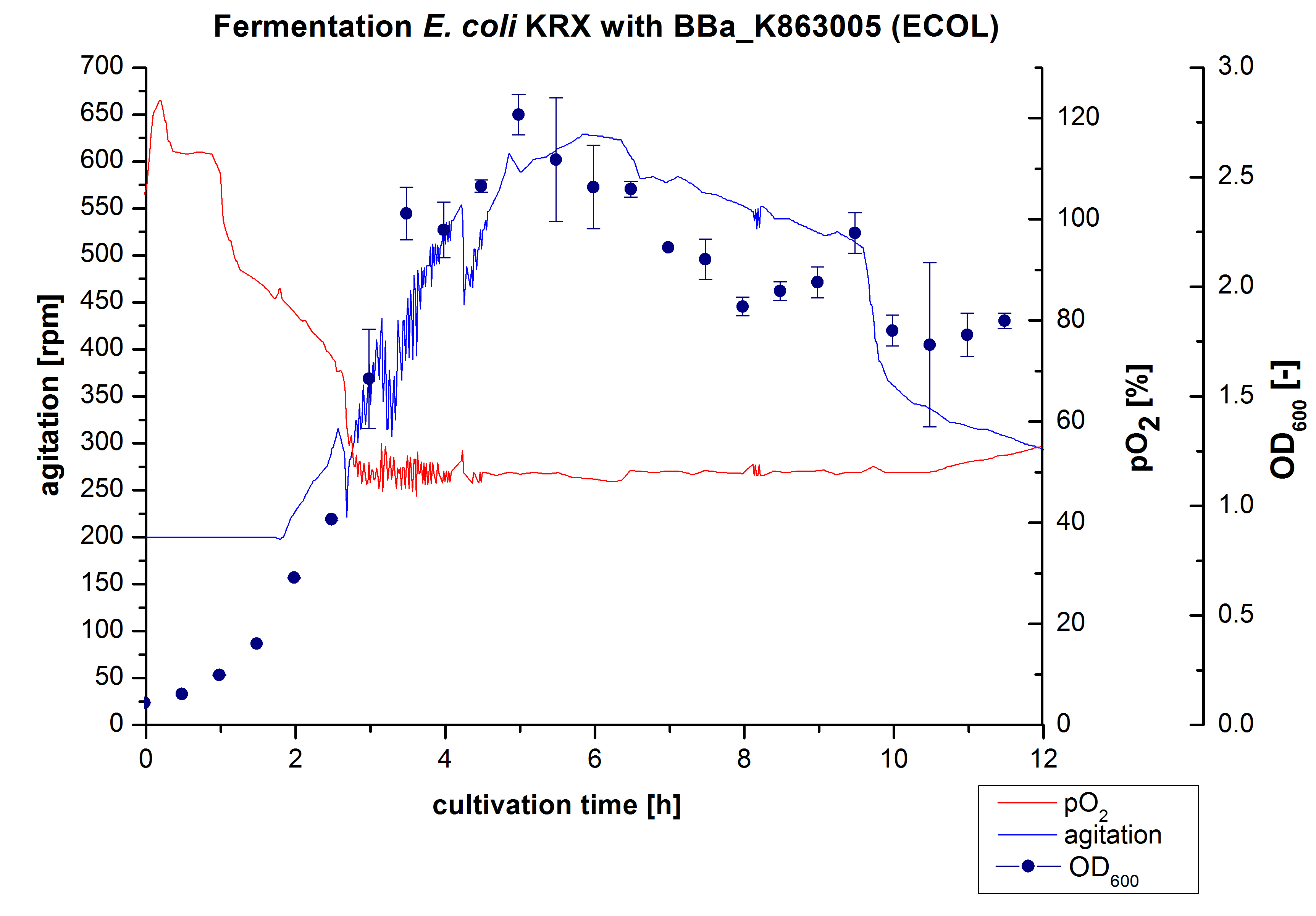
After the positive measurement of activity of ECOL we made a scale-up and fermented E. coli KRX with <partinfo>BBa_K863005</partinfo> in an Infors Labfors fermenter with a total volume of 3 L. Agitation speed, pO2 and OD600 were determined and illustrated in Figure 1. The exponential phase started after 1.5 hours of cultivation. The cell growth caused a decrease in pO2. After 2 hours of cultivation the agitation speed increased up to 629 rmp (5.9 hours) to hold the minimal pO2 level of 50 %. Then, after 4 hours there was a break in cell growth due to induction of protein expression. The maximal OD600 of 2.78 was reached after 5 hours. In comparison to E. coli KRX (OD600,max =4.86 after 8.5 hours) and to E. coli KRX with <partinfo>BBa_K863000</partinfo> (OD600,max =3.53 after 10 hours, time shift due to long lag phase) the OD600 max is lower. In the following hours, the OD600 and the agitation speed decreased and the pO2 increased, which indicates the death phase of the cells. This is caused by the cell toxicity of ECOL (reference: [http://www.dbu.de/OPAC/ab/DBU-Abschlussbericht-AZ-13191.pdf DBU final report]). Hence, cells were harvested after 12 hours.
Purification of ECOL
The harvested cells were resuspended in Ni-NTA- equilibration buffer, mechanically disrupted by homogenization and cell debris were removed by centrifugation. The supernatant of the cell lysate was loaded on the Ni-NTA column (15 mL Ni-NTA resin) with a flow rate of 1 mL min-1 cm-2. Then the column was washed with 10 column volumes (CV) Ni-NTA equilibration buffer. The bound proteins were eluted by an increasing Ni-NTA elution buffer step elution from 5 % (equates to 25 mM imidazol) with a length of 50 mL, to 50 % (equates to 250 mM imidazol) with a length of 60 mL, to 80 % (equates to 400 mM imidazol) with a length of 40 mL and finally to 100 % (equates to 500 mM imidazol) with a length of 80 mL. This strategy was chosen to improve the purification caused by a step by step increasing Ni-NTA-elution buffer concentration. The elution was collected in 10 mL fractions. In Figure 2 only the UV-detection signal of the wash step and the elution are shown, this is because of the high UV-detection signal of the loaded samples and to simplify the illustration of the detected product peak. A typical chromatogram of purified laccases is illustrated here. The chromatogram of the ECOL elution is shown in Figure 2:
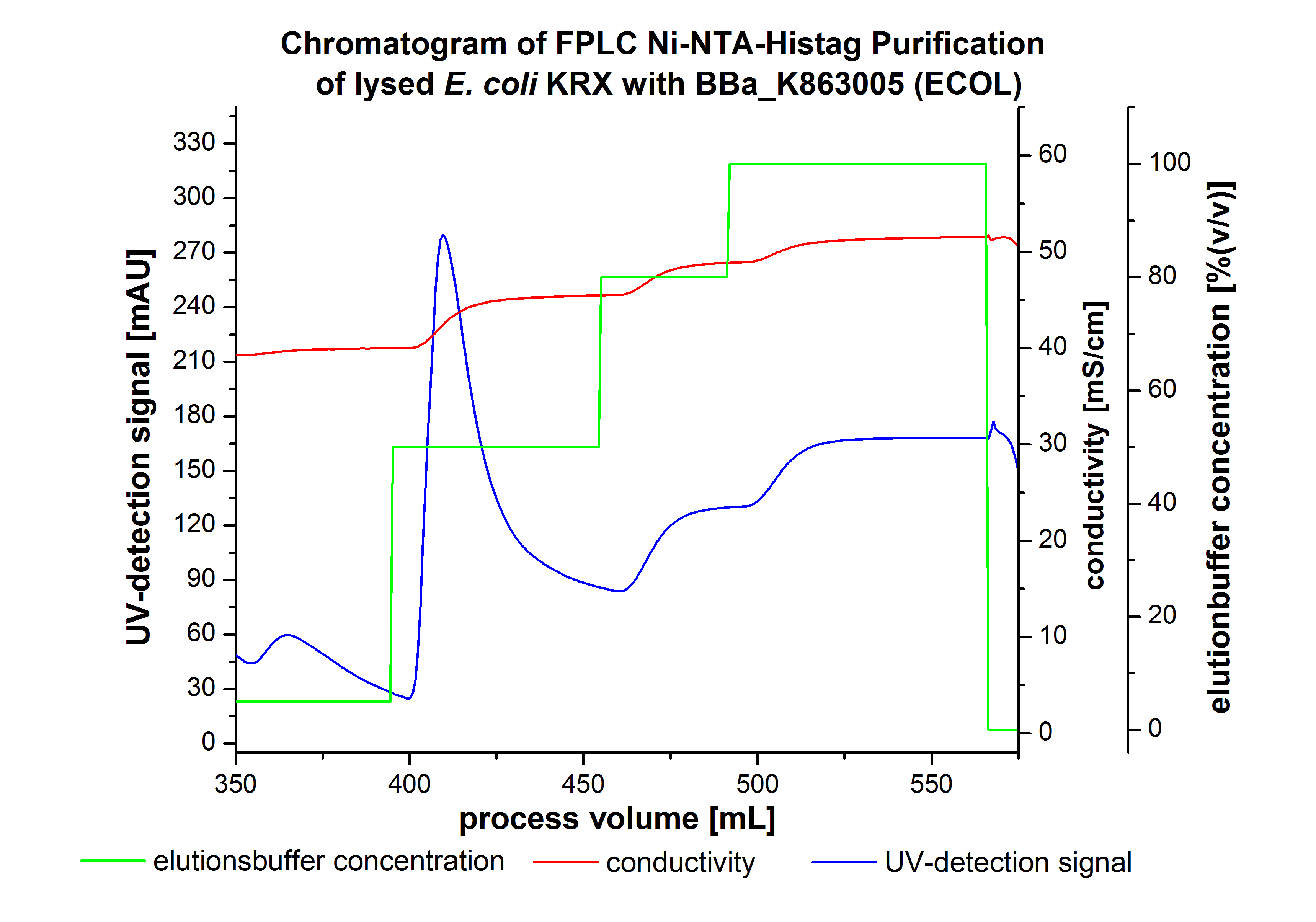
The chromatogram shows two distinguished peaks. The first peak was detected at a Ni-NTA-equilibration buffer concentration of 5 % (equates to 25 mM imidazol) and resulted from the elution of weakly bound proteins. After increasing the Ni-NTA elution buffer concentration to 50 % (equates to 250 mM imidazol), an UV-detection signal peak of 292 mAU was measured. The area of this peak indicates that a high amount of protein was eluted. The corresponding fractions were analyzed by SDS-PAGE to detect ECOL. There were no further peaks detectable. The following increasing UV detection signal results from the rising imidazol concentration of the Ni-NTA elution buffer. The corresponding SDS-PAGES are shown in Figure 3.
SDS-PAGE of ECOL purification

In Figure 3 the SDS-PAGE of the Ni-NTA His tag purification of the lysed culture (E. coli KRX containing [http://partsregistry.org/wiki/index.php?title=Part:BBa_K863005 BBa_K863005]) is shown including the flow-through and the fractions 2 to 9. The red arrow indicates the band of ECOL with a molecular weight of 53.4 kDa, which appears in all fractions. The strongest bands appear in fractions 6 and 7. These were the first two fractions (each 10 mL) eluted with 50 % Ni-NTA elution buffer (equates to 250 mM imidazol), in which the distinguished peak appeared.
These bands were analyzed by MALDI-TOF and identified as CueO (ECOL). In contrast, the second, faint band with a lower molecular weight could not be identified.
6 L Fermentation of E. coli KRX with <partinfo>BBa_K863005</partinfo>

Another scale-up of the fermentation of E. coli KRX with <partinfo>BBa_K863005</partinfo> was made up to a final working volume of 6 L in a Bioengineering NFL 22 fermenter. Agitation speed, pO2 and OD600 were determined and illustrated in Figure 4. There was no noticeable lag phase and the cells immediately began to grow. The cells were in an exponential phase between 2 and 4 hours of cultivation, which results in a decrease of pO2 value and therefore in an increase of agitation speed. After 4 hours of cultivation the maximal OD600 of 2.76 was reached, which is comparable to the 3 L fermentation of E. coli KRX with <partinfo>BBa_K863005</partinfo>. Due to induction of protein expression there is a break in cell growth. The death phase started, which is indicated by an increasing pO2 and a decreasing OD600. This demonstrates the cytotoxicity of the laccase for E. coli, which was reported by the [http://www.dbu.de/OPAC/ab/DBU-Abschlussbericht-AZ-13191.pdf DBU]. In comparison to the fermentation of E. coli KRX with <partinfo>BBa_K863000</partinfo> under the same conditions (OD600,max= 3.53), the OD600,max was lower. Cells were harvested after 12 hours.
Purification of ECOL
The harvested cells were resuspended in Ni-NTA-equilibration buffer, mechanically disrupted by homogenization and cell debris were removed by centrifugation. The supernatant of the cell lysate was loaded on the Ni-NTA column (15 mL Ni-NTA resin) with a flow rate of 1 mL min-1 cm-2. The column was washed by 10 column volumes (CV) Ni-NTA- equilibration buffer. The bound proteins were eluted by an increasing Ni-NTA- elution buffer gradient from 0 % to 100 % with a length of 200 mL and the elution was collected in 10 mL fractions. In Figure 5 only the UV-detection signal of the wash step and the elution are shown, this is because of the high UV-detection signal of the loaded samples and to simplify the illustration of the detected product peak. A typical chromatogram of purified laccases is shown here. The chromatogram of the ECOL elution is shown in Figure 5:
After washing the column with 10 CV Ni-NTA-elution buffer the elution process was started. At a process volume of 670 mL to 750 mL the chromatogram shows a remarkable widespread peak (UV-detection signal 189 mAU) caused by the elution of a high amount of proteins. The run of the curve show a fronting. This can be explained by the elution of weakly bound proteins, which elutes at low imidazol concentrations. A better result could be achieved with a step elution strategy (see purification of the 3 L Fermentation above). To detect ECOL the corresponding fractions were analyzed by SDS-PAGE.
SDS-PAGES of ECOL purification

In Figure 6 the SDS-PAGE of the Ni-NTA His tag purification of the lysed culture E. coli KRX containing [http://partsregistry.org/wiki/index.php?title=Part:BBa_K863005 BBa_K863005] (6 L fermentation) including the flow-through, wash and the fractions 1 to 15 (except from fraction 11/12) is shown. The red arrow indicates the band of ECOL with a molecular weight of 53.4 kDa, which appears in all fractions. The strongest bands appear from fractions 3 and 8 with a decreasing amount of other non-specific bands. In summary, the scale up was successful, improving protein production and purification once again.
Furthermore the bands were analyzed by MALDI-TOF and identified as CueO (ECOL).
Since Regionals: 12 L Fermentation E. coli KRX with <partinfo>BBa_K863005</partinfo>

Finally another scale-up was made and E. coli KRX with <partinfo>BBa_K863005</partinfo> was fermented in an Bioengineering NLF 22 fermenter with a total volume of 12 L to produce a high amount of the enzyme for further characterizations. This time HSG autoinduction medium was used to get a higher biomass. Agitation speed, pO2 and OD600 were determined and the glycerin concentration of the samples analyzed. The data are illustrated in Figure 7. For adaption to the medium, there was a lag phase of one hour. Between the 3 and 8 hours of cultivation the cells were in the exponential phase. During this phase the cells consumed O2, so that the agitation speed was increased automatically, as well as glycerin. After 11 hours of cultivation the pO2 increased, the glycerin was completely consumed and the cells were in the stationary phase. The maximal OD600 of 11.1 was reached after 15 hours of cultivation. The cells were harvested after 19 hours of cultivation.
Since Regionals: Purification of ECOL
The harvested cells were resuspended in Ni-NTA- equilibration buffer, mechanically disrupted by homogenization and cell debris were removed by centrifugation, microfiltration as well as diafiltration to concentrate the protein concentration in the cell lysate solution. This solution of the cell lysate was loaded on the Ni-NTA column (15 mL Ni-NTA resin) with a flow rate of 1 mL min-1 cm-2. Then the column was washed with 10 column volumes (CV) Ni-NTA equilibration buffer. The bound proteins were eluted by an increasing Ni-NTA elution buffer step elution from 5 % (equates to 25 mM imidazol) with a length of 40 mL, to 50 % (equates to 250 mM imidazol) with a volume of 80 mL, to 80 % (equates to 400 mM imidazol) and finally to 100 % (equates to 500 mM imidazol) with a volume of 80 mL. This strategy was chosen to improve the purification caused by a step by step increasing Ni-NTA-elution buffer concentration. The elution was collected in 10 mL fractions. In Figure 8 only the UV-detection signal of the wash step and the elution are shown, this is because of the high UV-detection signal of the loaded samples and to simplify the illustration of the detected product peak. A typical chromatogram of purified laccases is illustrated here. The chromatogram of the ECOL elution is shown in Figure 8.
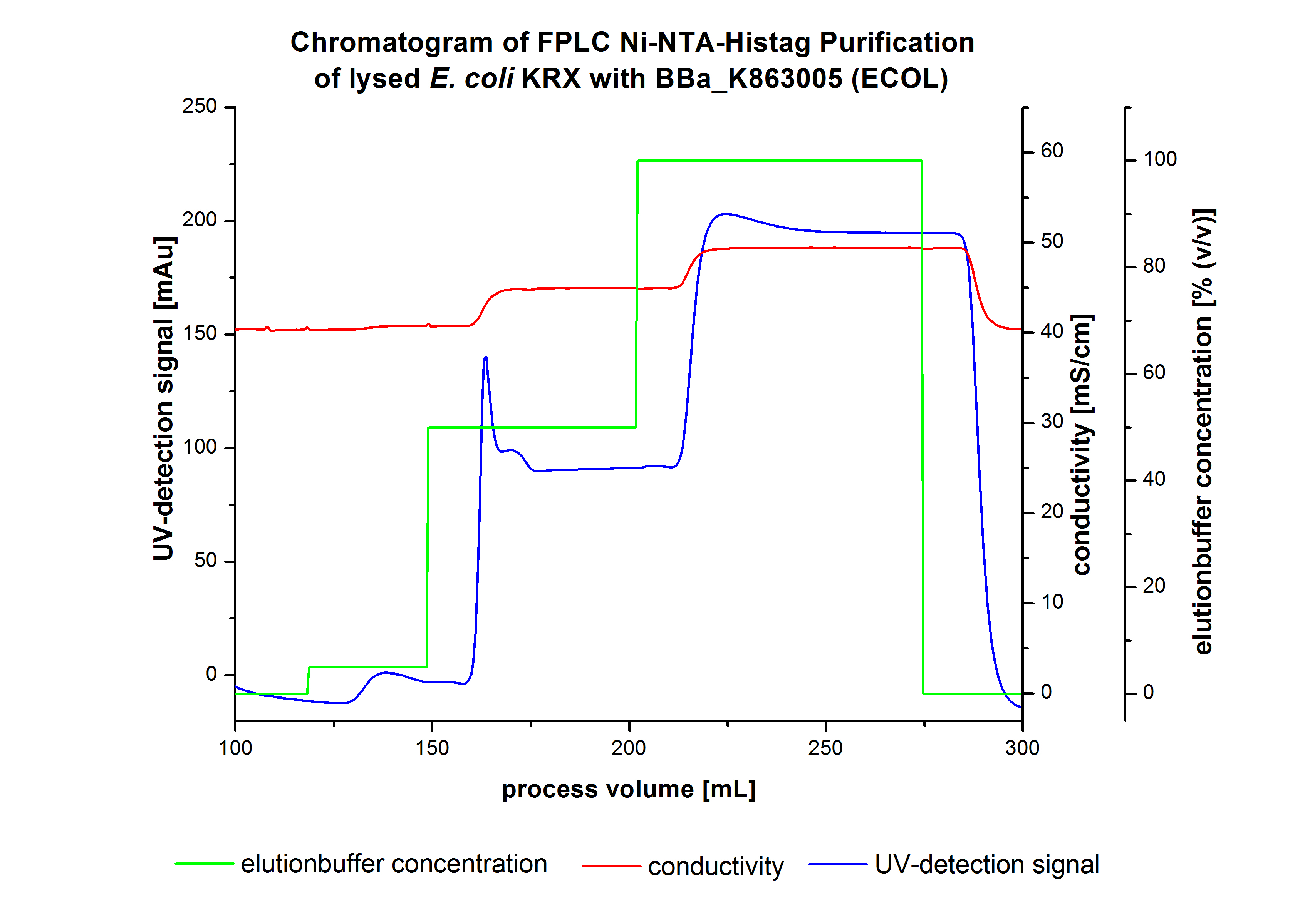
The chromatogram shows two distinguished peaks. The first peak was detected at a Ni-NTA-equilibration buffer concentration of 5 % (equates to 25 mM imidazol) and resulted from the elution of weakly bound proteins. After increasing the Ni-NTA elution buffer concentration to 50 % (equates to 250 mM imidazol), an UV-detection signal peak of 140 mAU was measured. The area of this peak indicates that a high amount of protein was eluted. In addition, a second peak right behind the first peak can be detected. At this point it is not clear which peak contains our product and which peak is caused by impurities. The corresponding fractions were analyzed by SDS-PAGE to detect ECOL. A last peak can be detected after increasing the elution buffer concentration to 100 % (equates to 500 mM imidazol). This peak could be explained by impurities which were strongly bound on the Ni-NTA-resin. All corresponding fractions with an UV-signal were analyzed by SDS-PAGES. The Results are shown in Figure 9.
Since Regionals: SDS-Page of protein purification
In Figure 9 the SDS-PAGE of the Ni-NTA purification of the lysed E.coli KRX culture containing [http://partsregistry.org/wiki/index.php?title=Part:BBa_K863005 BBa_K863005] is illustrated. It shows the permeate and retentate of microfiltration and diafiltration respectively, several fractions of flow-through, wash and the elutions with different buffer concentrations respectively. The selected samples were taken where peaks were seen in the chromatogram. The His-tagged BPUL has a molecular weight of 53.4 kDa. The red arrow shows ECOL. Unfortunately it could not be identified because the MALDI was broken-down for the last two weeks.
MALDI-TOF Analysis of ECOL
The E. coli laccase was identified using the following software
- FlexControl
- Flexanalysis and
- Biotools
Activity Analysis of [http://partsregistry.org/wiki/index.php?title=Part:BBa_K863005 ECOL]
Initial activity tests of purified fractions
Initial tests were done with elution fractions 2, 3, 6, 7 and 8 to determine the activity of the purified [http://partsregistry.org/Part:BBa_K863005 ECOL] laccase. The fractions were rebuffered into deionized H2O using [http://www.sigmaaldrich.com/content/dam/sigma-aldrich/docs/Supelco/Product_Information_Sheet/4774.pdf HiTrap Desalting Columns] and incubated with 0.4 mM CuCl2. The reaction setup included 140 µL of a elution fraction, 100 mM sodium acetate buffer (pH 5), and 198 deionized H2O and 0.1 mM ABTS and the absorption was measured at 420 nm to detect oxidization over a time period of 12 hours at 25°C. Each fraction contained active laccase able to oxidize ABTS (see Figure 12). After 1 hour saturation was observed with ~52 µM oxidized ABTS. After 12 hours ~10 µM ABTS got reduced again, if referred to fraction 6. This behavior has been observed in the activity plot ofTVEL0 before, indicating, that the oxidation catalyzed by this laccase is reversible. Additionally protein concentrations of each fraction were identified using the Bradford protocol. The tested fractions showed different amounts of protein after rebuffering, ranging from 0.2 to 0.6 mg mL-1. Fraction 7, containing the most protein and also most of active laccase was chosen for subsequent activity tests of [http://partsregistry.org/Part:BBa_K863005 ECOL]. The protein concentration was reduced to 0.03 mg mL-1 for each measured sample to allow a comparison between TVEL0 measurements and [http://partsregistry.org/Part:BBa_K863005 ECOL] measurements.
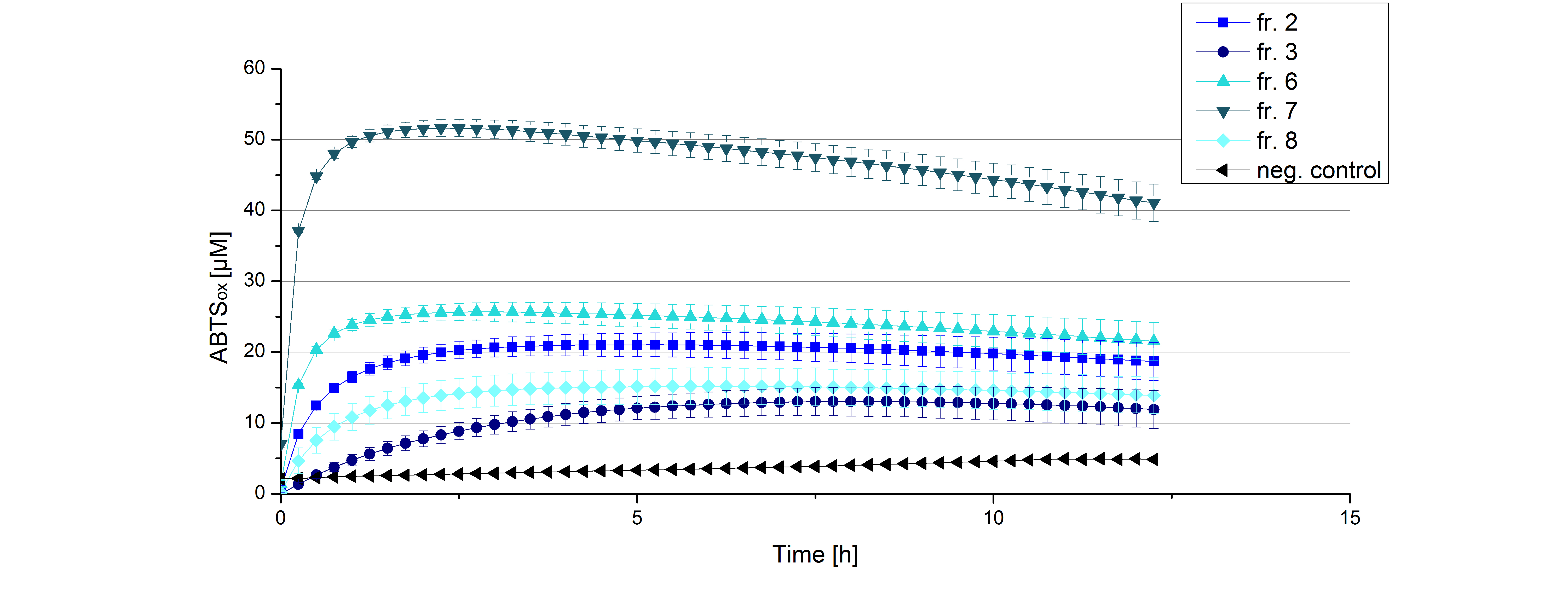
[http://partsregistry.org/Part:BBa_K863005 ECOL] pH optimum
Note: The experimental setup for the pH acticity assay was not well chosen. The buffering capacity of sodium acetate buffer is restricted to a smaller pH range than used in this experiment. The activity assay was optimized after the Regionals in Amsterdam to ensure correct measurements and values.
To determine at which pH the [http://partsregistry.org/Part:BBa_K863005 ECOL] laccase has its optimum in activity, a gradient of sodium acetate buffer pHs was prepared. Starting with pH 1 to pH 9 [http://partsregistry.org/Part:BBa_K863005 ECOL] activity was tested using the described conditions above and 0.03 mg mL-1 protein. The results are shown in Figure 13. A distinct pH optimum can be seen at pH 5. Saturation is reached after 2.5 hours with 53% oxidization of ABTS by the [http://partsregistry.org/Part:BBa_K863005 ECOL] laccase at pH 5 (53 µM oxidized ABTS). The other tested pHs only led to a oxidation of up to 17% of added ABTS, respectively. Figure 14 shows the results of the analog experiments with laccase that was not incubated with CuCl2 before the activity measurements. Again, a pH optimum at pH 5 can be determined with 24 µM ABTS (24%) oxidized by [http://partsregistry.org/Part:BBa_K863005 ECOL] after 8 hours under these conditions.
Figure 15 represents the negative control showing the oxidization of ABTS by 0.4 mM CuCl2 at the chosen pHs. The greatest increase in oxidized ABTS can be seen at a pH of 5: after 5 hours 15% ABTS is oxidized by CuCl2 alone. Nevertheless this result does not have an impact on the activity of the [http://partsregistry.org/Part:BBa_K863005 ECOL] laccase at pH 5, which is still the optimal pH. Therefore it has the same pH optimum as TVEL0.
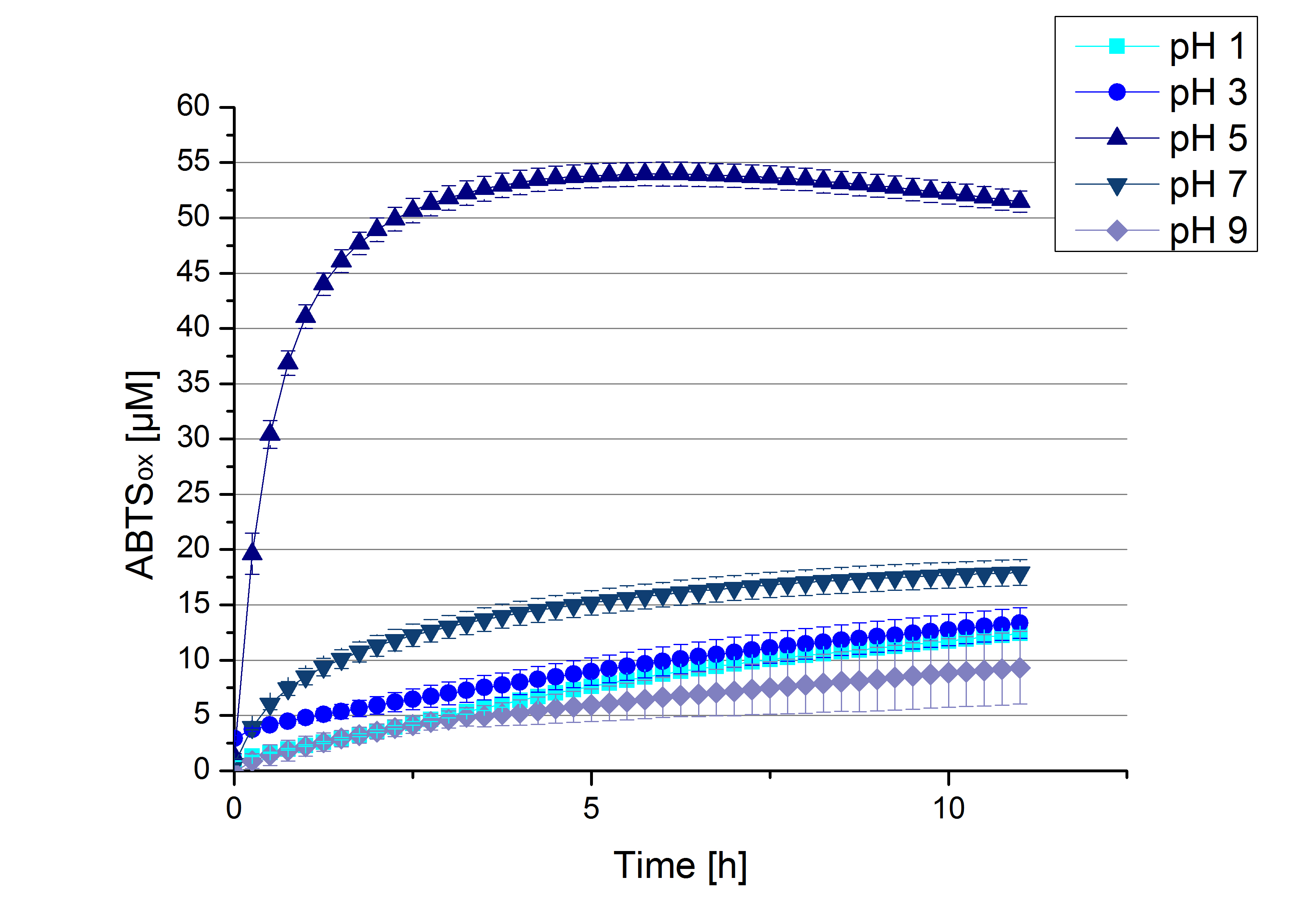
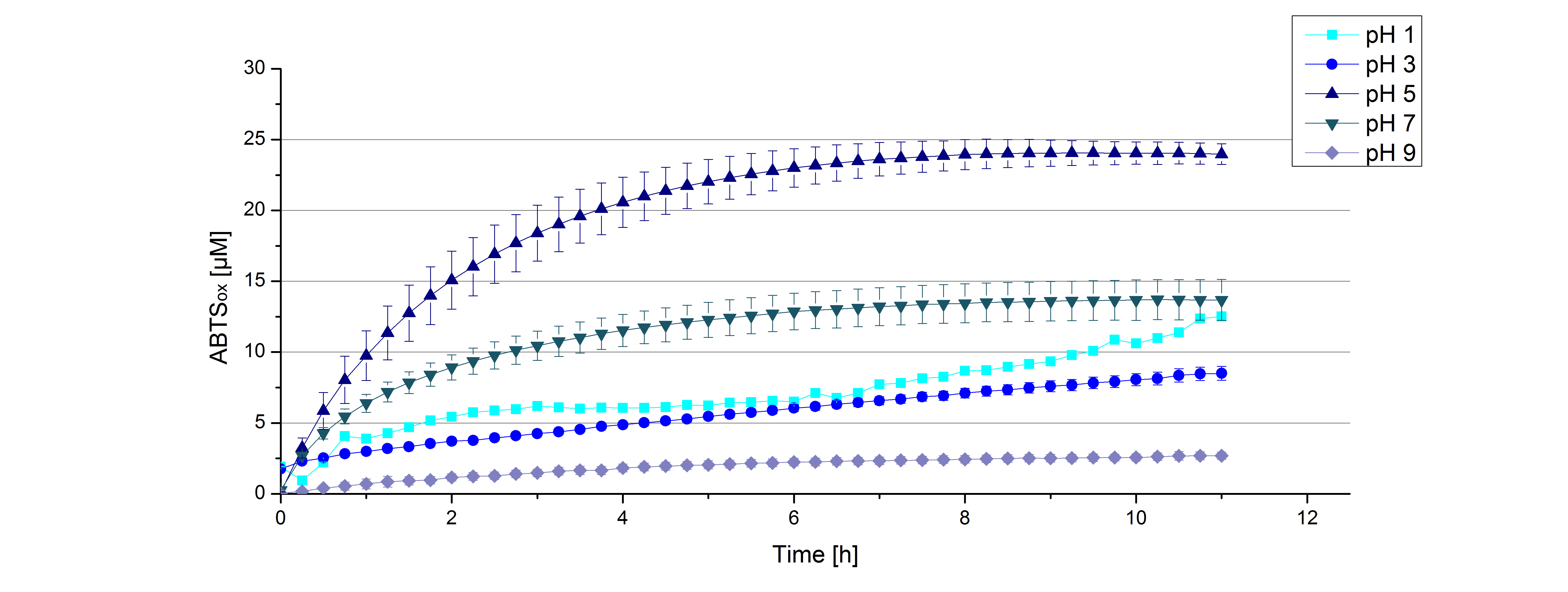
With regard to our project knowledge of the optimal pH is useful. Since waste water in waste water treatment plants has an average
pH of 6.9 it has to be kept in mind, that a adjustment of the pH is necessary for optimal laccase activity.
[http://partsregistry.org/Part:BBa_K863005 ECOL] CuCl2 concentration
Another test of [http://partsregistry.org/Part:BBa_K863005 ECOL] was done to survey the best CuCl2 concentration for the activity of the purified [http://partsregistry.org/Part:BBa_K863005 ECOL] laccase. 0.03 mg mL-1 protein were incubated with different CuCl2 concentration ranging from 0 to 0.7 mM CuCl2. Activity tests were performed with the incubated samples, in 100 mM sodium actetate buffer (pH 5), 0.1 mM ABTS, to a final volume of 200 µL. The activity was measured at 420 nm, 25°C and over a time period of 10 hours. As expected the saturation takes place after 5 hours (see Figure 16). The differences in the activity of [http://partsregistry.org/Part:BBa_K863005 ECOL] laccase incubated in different CuCl2 differ minimal. The highest activity of [http://partsregistry.org/Part:BBa_K863005 ECOL] laccase is observed after incubation with 0.4 mM CuCl2 (42% of added ABTS). With a higher concentration of 0.7 mM CuCl2 the activity seems to be reduced (only 41% ABTS got oxidized). This leads to the assumption that CuCl2 supports the [http://partsregistry.org/Part:BBa_K863005 ECOL] laccase activity but concentrations exceeding this value of CuCl2 may have a negative impact on the ability of oxidizing ABTS. Without any CuCl2 application [http://partsregistry.org/Part:BBa_K863005 ECOL] laccase show less activity in oxidizing ABTS (see Figure 16). This fits the expectations as laccases are copper reliant enzymes and gain their activity through the incorporation of copper. Additionally negative controls were done using the tested concentrations of CuCl2 but no laccase was added to detect the oxidization of ABTS through copper (see Figure 17). The more CuCl2 was present, the more ABTS was oxidized after 5 hours. Still the maximal change accounts only for ~6% oxidized ABTS after 5 hours.
In relation to apply the laccase in waste water treatment plants it is beneficial knowing, that small amounts of CuCl2 are enough to activate the enzymes. This reduces the cost factor for the needed CuCl2 to incubate the laccases before application.
[http://partsregistry.org/Part:BBa_K863005 ECOL] activity at different temperatures
To investigate the activity of [http://partsregistry.org/Part:BBa_K863005 ECOL] at lower temperatures activity tests as described above were done at 10°C and 25°C (Figure 18). A significant decrease in the activity can be observed upon reducing the temperature from 25°C to 10°C. While the activity at 10 °C is reduced, final saturation levels are still comparable: after 3,5 hours, only 2% difference in oxidized ABTS is observable. The negative control without the [http://partsregistry.org/Part:BBa_K863005 ECOL] laccase and only 0.4 mM CuCl2 at 10°C shows a negligible oxidation of ABTS. Although a decrease in the activity of [http://partsregistry.org/Part:BBa_K863005 ECOL] laccase was expected the observed reduction in enzyme activity is problematic for the possible application in waste water treatment plants where the temperature differs from 8.1°C to 20.8°C. A more cryo tolerant enzyme would be preferable.
[http://partsregistry.org/Part:BBa_K863005 ECOL] activity depending on different ABTS concentrations
Furthermore [http://partsregistry.org/Part:BBa_K863005 ECOL] laccase were tested using different amounts of ABTS to calculate KM and Kcat values. The same measurement setup as described above was used only with different amounts of ABTS. As anticipated the amount of oxidized ABTS increased in dependence of the amount of ABTS used (Figure 19). The results of the measurements of the samples tested with 16 µL could not be detected longer than 1.5 h because the values were higher than the detection spectrum of the device used (TecanReader).
Impact of MeOH and acetonitrile on [http://partsregistry.org/Part:BBa_K863005 ECOL]
For substrate analytic tests the influence of MeOH and acetonitrile on [http://partsregistry.org/Part:BBa_K863005 ECOL] laccase had to be determined, because substrates have to be dissolved in these reagents. The experiment setup included 0.03 mg mL-1 [http://partsregistry.org/Part:BBa_K863005 ECOL] laccase, 100 mM sodium acetate buffer, different amounts of MeOH (Figure 20) or acteonitrile (Figure 21), 0.1 mM ABTS, to a final volume of 200 µL. The activity of [http://partsregistry.org/Part:BBa_K863005 ECOL] was found to be increased in presence of low concentrations (1 % v/v) of either MeOH or acetonitrile resulting in an higher amount of oxidized ABTS after 5 hours. Increasing concentrations of either substance decrease this positive effect, resulting in a significantly decreased laccase activity in presence of 8 % (v/v) MeOH. These results indicate that for further measurements in substrate analytics it is recommended not to use high concentrations of MeOH or acetonitrile to ensure the functionality of [http://partsregistry.org/Part:BBa_K863005 ECOL].
Since Regionals: Initial activity tests of purified fractions
Another cultivation of ECOL has been done after the Regional Jamboree in Amsterdam. The fractions of the purifictaion were analyzed further on protein content and re-buffered subsequently into deionized H2O. To determine the protein content afterwards because of loss of proteins through re-buffering, another protein concentration measurement has been done. The re-buffered fractions have been incubated with 0.4 mM CuCl2 to gain higher activity of the laccases, because they are copper-dependent. Standard activity tests were done with all ECOL fractions with adjusted protein content for comparison. The experimental setup included the ECOL fractions, Britton-Robinson buffer (pH 5) and 0.1 mM ABTS. Measurements were done at 25 °C. Resulting, one fraction showed very high activity in comparison to the other fractions (see Fig. 22). This fraction, fraction 50% 2, oxidized up to 23 µM ABTS after 5 hours. The first number of the sample indicates the percentage of used elution buffer, whereas the second number stands for the fraction number of this elution. This fraction was set as containing 90 % ECOL laccase of the whole protein content. Therefore a ECOL concentration of 63,9 µg mL-1 was gained. This fraction was analyzed further on pH optimum, temperature dependency and ABTS saturation.
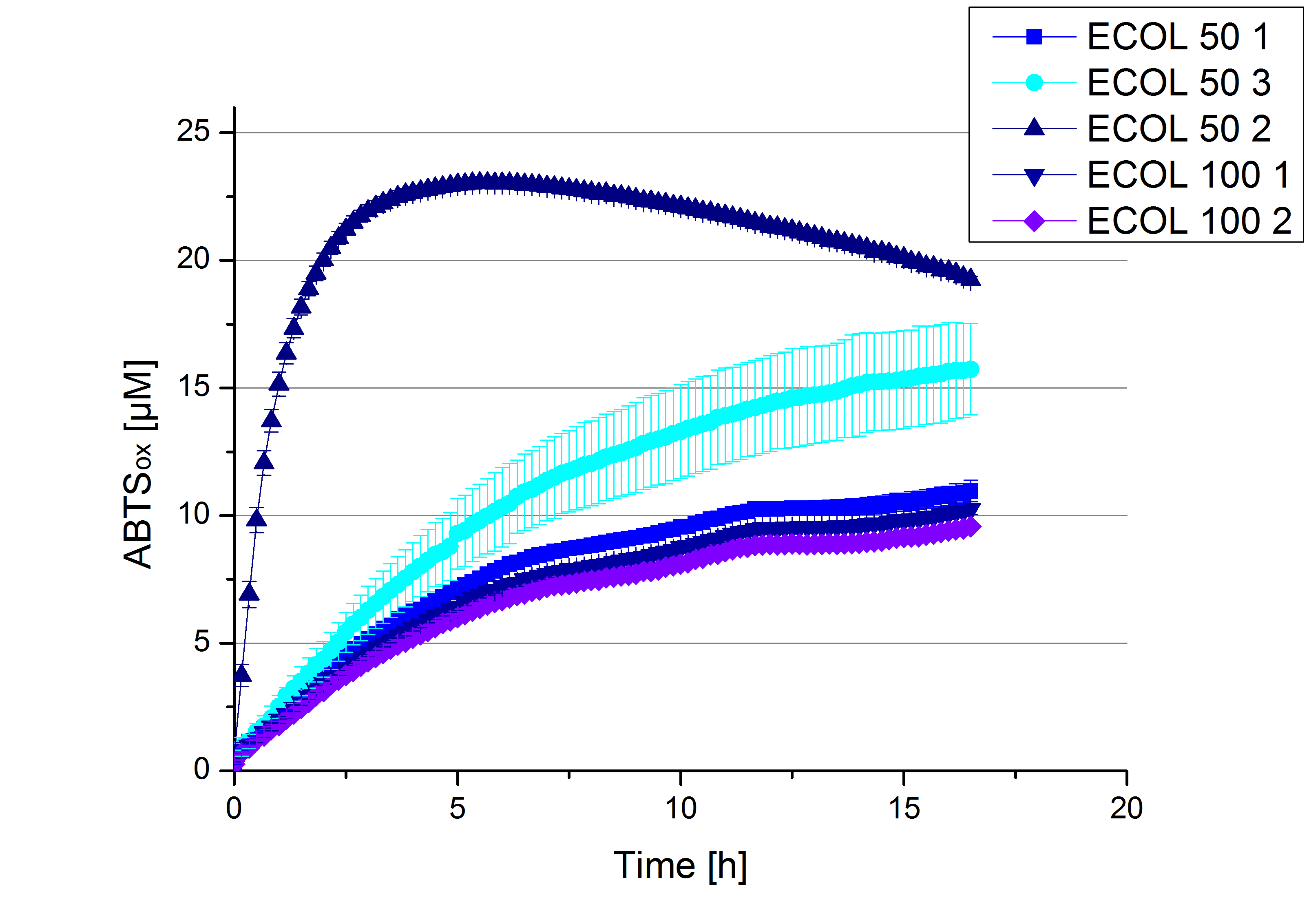
Since Regionals: [http://partsregistry.org/Part:BBa_K863005 ECOL] activity depending on different ABTS concentrations
To calculate the activity in Units mg-1, measurements had to be done under substrate saturation. With this the comparison of Units mg-1 with other laccase activities and the literature is possible. To find the optimal substrate saturation ABTS concentrations ranging from 0.1 mM to 8 mM were applied in an experimental setup containing Britton-Robinson buffer (pH 5) and temperature conditions of 25 °C. For measurements with 0.1 mM to 5 mM ABTS, 616 ng BHAL laccase were used (see Fig. 23). For measurements with 5 mM to 8 mM ABTS only 308 ng BHAL laccase were applied (see Fig. 24). The amount of oxidized ABTS increased according to the increase of ABTS concentration. To make sure that the substrate saturation is given, 9 mM ABTS have been used in further tests.
Since Regionals: [http://partsregistry.org/Part:BBa_K863005 ECOL] pH optimum
Activity assay measurements for ECOL laccases were done to find the optimal pH for further analysis. Britton-Robinson buffer, adjusted to pHs ranging from pH 4 to pH 9, was used with 9 mM ABTS to detect the change in OD420. The measurements were done with 308 ng ECOL laccase for each sample. The highest activity was reached when measured in Britton-Robinson buffer at pH 4 and pH 5 (see Fig. 25, Fig. 26 and Fig. 27). More than 5 U mg-1 of specific enzyme activity have calculated for these pHs (see Fig. 27). When testing the activity under basic conditions, the enzyme activity decreases. At pH 7 about 1 U mg-1 was determined. This makes an application of the ECOL not feasible since the water in the waste water treatment plants is in average of pH 6.9.
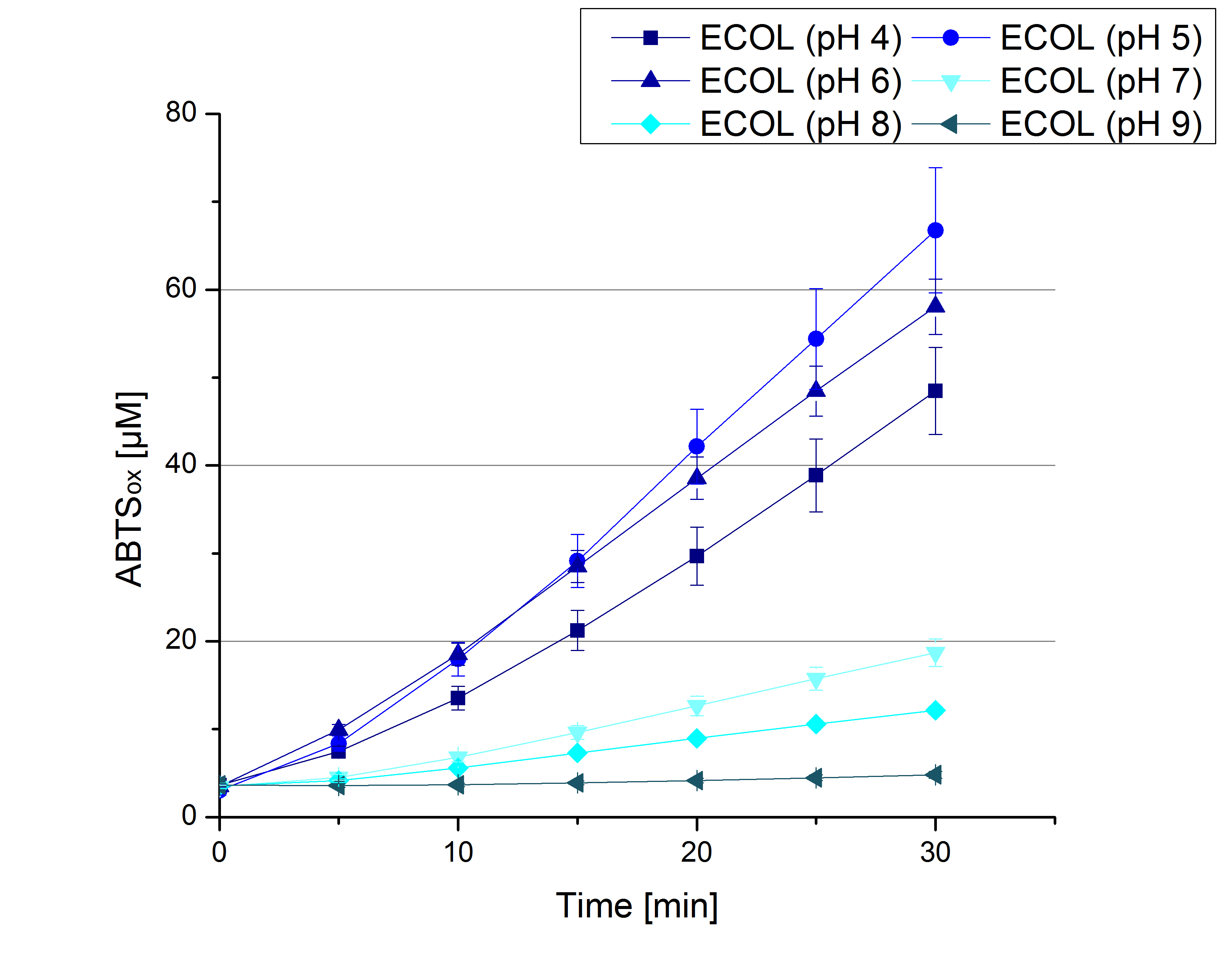
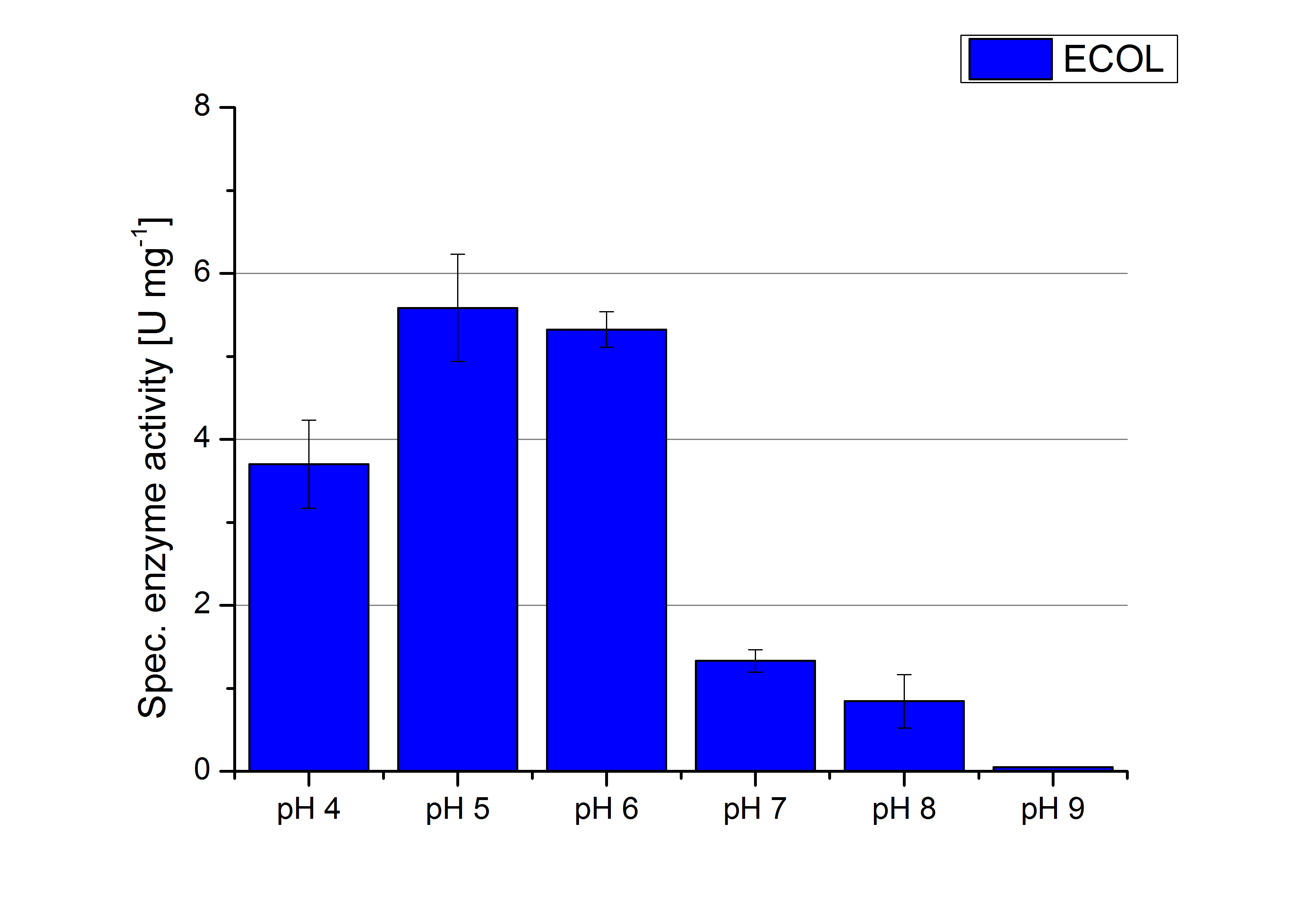
Since Regionals: [http://partsregistry.org/Part:BBa_K863005 ECOL] activity at different temperatures
To investigate the activity of ECOL at temperatures that will apply at a waste water treatment plant throughout the year, activity tests were performed at 10 °C and 25 °C as described above. The measurements were conducted for 30 minutes. The obtained results reveal a lower activity of ECOL at 10 °C in comparison to 25 °C (see Fig. 28). The received values were used to calculate the specific enzyme activity which was between 1 and 12 U mg-1 , respectively (see Fig. 29). The negative control without ECOL but 0.4 mM CuCl2 at 10 °C and 25 °C show a negligible oxidation of ABTS. The activity of ECOL is decreased to about 90% at 10 °C. An application of ECOL at warm temperatures is therefore possible but during the cold seasons a more cryo stable enzyme would be preferable.
Substrate Analysis
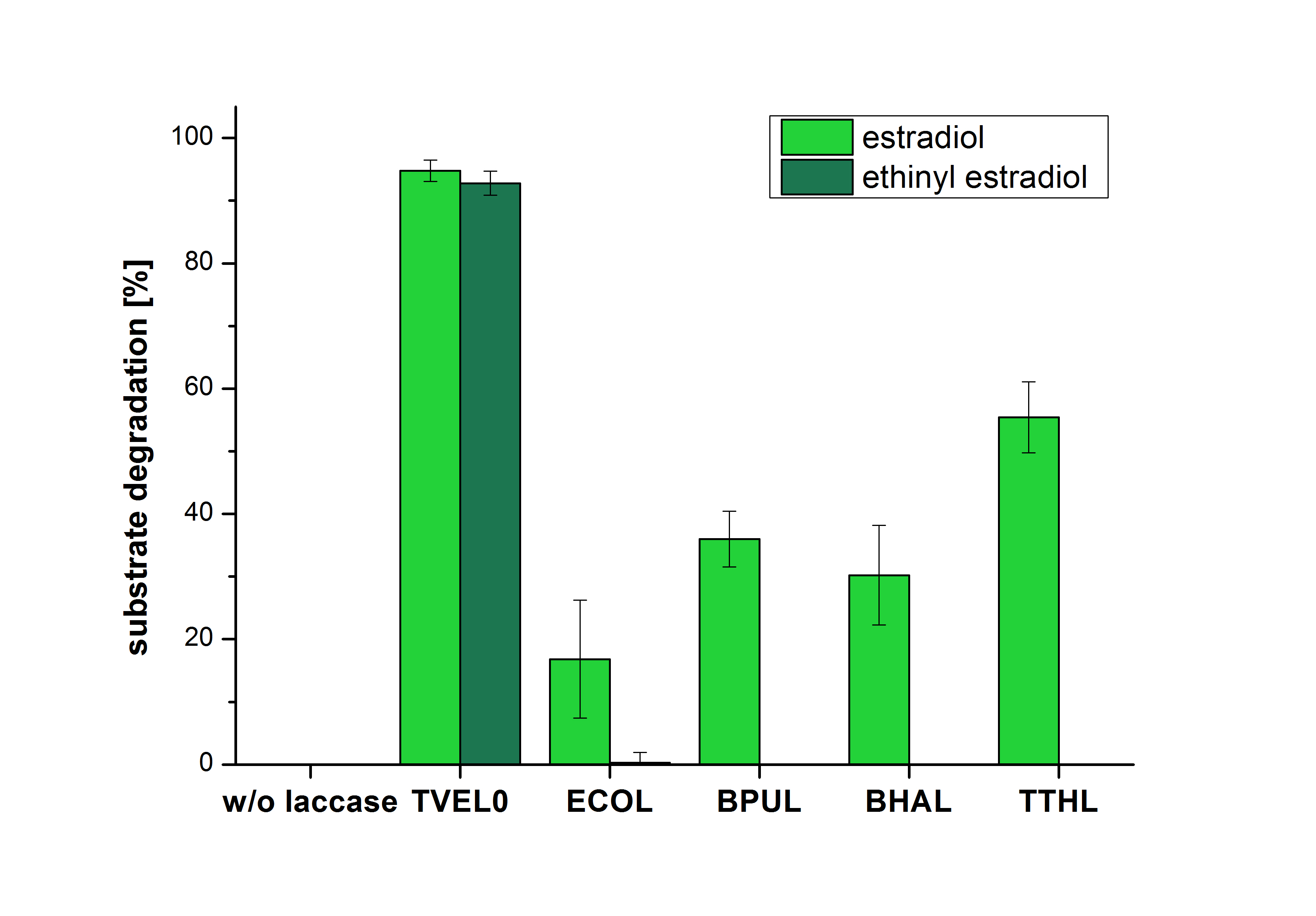
The measurements were made to test if the produced laccases were able to degrade different hormones. Therefore the produced laccases were inserted in the same concentrations (3 µg mL-1) to the different measurement approaches. To work with the correct pH value (which were measured by the Team Activity Test) Britton Robinson buffer at pH 5 was used for all measurements. The initial substrate concentration was 5 µg mL-1. The results of the reactions without ABTS are shown in Figure 30. On the Y-axis the percentages of degraded estradiol (blue) and ethinyl estradiol (red) are indicated. The X-axis displays the different tested laccases. The degradation was measured at t0 and after five hours of incubation at 30 °C. The negative control was the substrate in Britton Robinson buffer and showed no degradation of the substrates. The bought laccase TVEL0 which is used as positive control is able to degrade 94.7 % estradiol and 92.7 % ethinyl estradiol. The laccase BPUL (from Bacillus pumilus) degraded 35.9 % of used estradiol after five hours. ECOL was able to degrade 16.8 % estradiol. BHAL degraded 30.2 % estradiol. The best results were determined with TTHL (laccase from Thermus thermophilus). Here the percentage of degradation amounted 55.4 %.

The results of the reactions of the laccases with addition of ABTS are shown in Figure 31. The experimental set ups were the same as the reaction approach without ABTS described above. The X-axis displays the different tested laccases. On the Y-axis the percentages of degraded estradiol (blue) and ethinyl estradiol (red) are shown. The degradation was measured at t0 and after five hours of incubation at 20 °C. The negative control showed no degradation of estradiol. 6.8 % of ethinyl estradiol was decayed. The positive control TVEL0 is able to degrade 100 % estradiol and ethinyl estradiol. The laccase BPUL (from Bacillus pumilus) degraded 46.9 % of used estradiol after ten minutes incubation. ECOL was able to degrade 6.7 % estradiol. BHAL degraded 46.9 % estradiol. With TTHL (laccase from Thermus thermophilus)a degradation 29.5 % were determined.
Immobilization
Figure 32 shows the percentage of laccases bound after incubation with CPC-beads, relative to the original concentration. The concentration of laccases in the supernatant after incubation was measured using Roti®-Nanoquant. The results showed that only 1% of ECOL laccases was still present in the supernatant. This illustrates that ECOL was successfully immobilized on the CPC-beads.
In Figure 33, the enzymatic activity of ECOL in the supernatant is compared to the activity of nontreated ECOL. Although an activity can already be detected in the supernatant, this activity is low compared to the original.
Figure 34 shows the illustration of ABTS oxidation by ECOL with time compared to the negative control. The increase in ABTS oxidized proves laccase activity even if a direct comparison with the original and not immobilized laccase solution was not possible due to the measuring methods.
| 55px | | | | | | | | | | |
nbsp;°C. The negative control was the substrate in Britton Robinson buffer and showed no degradation of the substrates. The bought laccase TVEL0 which is used as positive control is able to degrade 94.7
 "
"







